Bulletin – February 2003 Statement on Monetary Policy
Download the complete Statement 712KB
After a promising start in the early part of 2002, the global recovery lost momentum towards the end of the year. Most of the major economies showed little or no growth in the final months of the year, although there have remained areas of relatively strong performance among the smaller and medium-sized economies, notably in parts of east Asia. Australia, too, has continued to perform quite strongly, though prospects will depend importantly on how quickly the momentum in the major economies is regained.
Whether the recent weakness in the major economies signals a sustained setback to the global recovery, or represents a more temporary pause in growth, remains to be seen, and in this respect the US economy will remain an important driver of global trends. Despite posting good growth on average in the first three quarters of 2002, the US still appears to be hampered to some extent by the imbalances that had earlier pushed the economy into recession. In particular, business profits are still weak, and corporate balance sheets remain in relatively poor condition. On the other hand, household spending has been quite resilient, and macroeconomic policies are providing considerable stimulus. In addition to the sharp reductions in official interest rates since early 2001, fiscal policy has made a strong contribution to spending growth over the past two years, with an additional package likely to add further to growth in the year ahead. It may well be that these measures are sufficient to generate a self-sustaining expansion. Certainly they have been well timed, in the sense of providing a powerful stimulus at around the low-point in the economic cycle.
Among the other main economic regions, growth has generally been disappointing. The euro area has grown only very modestly over the past year, and has shown little sign of generating any pick-up in domestic demand, though the recent reductions in official interest rates by the European Central Bank (ECB) will provide some stimulus. The Japanese economy, despite being weighed down by longstanding structural problems, experienced some export-led growth during the first three quarters of 2002, but turned down again in line with the weaker global conditions towards the end of the year. The main exceptions to the generally disappointing international picture have been in east Asia, with China and Korea in particular both continuing to grow strongly.
The weakening in world economic growth in the closing months of 2002, reinforced by the uncertainties over Iraq, was reflected in three main developments in global financial markets: renewed weakness in equity prices, falls in bond yields, and a further decline in the US dollar. It also led to the resumption of monetary easing by a number of central banks, including importantly both the US Federal Reserve and the ECB. For the industrial countries as a whole, official interest rates are at average levels not previously seen in the post-war period.
Some of these recent international developments have had direct effects on Australian financial markets. Domestic long-term interest rates, which tend to be heavily influenced by those in the US, have fallen noticeably, for example. There has also been a tendency for markets to price in some possibility of an easing in domestic monetary policy, perhaps reflecting the tendency towards easing that seems to be apparent globally. In addition, the Australian dollar has risen against the weakening US dollar, though not against other major currencies, so the trade-weighted value of the Australian dollar (the most appropriate measure of the exchange rate) has risen only modestly. On the other hand, the Australian share market, while it has weakened a little, continues to be much more robust than most share markets overseas; the relative strength of the local economy has no doubt been a factor in this.
The Australian economy has continued to expand at a good pace in the recent period, despite the continued drag from the weak world economy and the drought. This outcome reflected continued strong growth in domestic demand, though the pace moderated somewhat in the second half of last year. The ongoing expansion of the economy has been sufficient to generate a further strengthening of the labour market, with the unemployment rate declining significantly during 2002. Another consequence of the strength in domestic demand, against the background of the weak global economy, is that Australia's current account deficit has widened significantly.
The business sector in Australia appears to be in much better shape than its counterparts abroad. Profitability is relatively high, and most surveys report that businesses are viewing current conditions as quite favourable. Notwithstanding some high-profile corporate failures during the past couple of years, businesses in aggregate are carrying low levels of debt, have strong internal funding, and have generally avoided the mistakes of over-investment that have characterised past business cycles. Against this background, it is not surprising that business investment is contributing strongly to expenditure growth at present or that employment is continuing to expand. Forward indicators of investment intentions and projects underway confirm that there are good prospects for further growth. The main risk to a continuation of these favourable trends would arise if there were a significant deterioration in confidence about future conditions associated with the international outlook. However, there is little indication that this is occurring at present; although there have been some signs of diminished confidence recently based on evidence from business surveys, they have generally been quite modest.
Household spending has also been contributing strongly to growth in the recent period, though the pace slowed to some extent in the second half of last year. The major determinants of consumer spending are supportive of continued growth. Consumer confidence remains above average, while real wage increases and strong employment growth have boosted household incomes in aggregate, though incomes in the rural sector have deteriorated sharply. Household borrowing has also continued at a rapid pace, a process that has been associated with rising housing prices.
The other major driver of the growth of domestic demand has been the upswing in housing construction. In some respects this has followed the pattern of a conventional housing cycle, though an important additional factor over the past couple of years was a much sharper run-up in investor demand than had been observed in earlier cycles. As has been discussed in previous Statements, this process has been closely inter-related with the increases in housing prices seen in recent years, with new investors being drawn to the market by expectations of continued capital gains.
Putting aside these short-run effects on household expenditures, the run-up in housing prices and associated expansion in housing-related debt were a source of concern for most of the past year, given the potential of such a process to remain disconnected from fundamentals and develop into a significant imbalance over time. These risks, however, appear to have eased somewhat in recent months. There is some evidence that investor activity, which had been a major driver of the market over the past two years, has moderated. Conditions of oversupply have led to cancellation of a number of multi-unit construction projects due to a lack of buyer interest, and there are signs that market pressures on housing prices have eased.
The Australian economy in aggregate looks set to continue to grow at a good pace although slower than last year. Indications are that the housing construction cycle will peak some time around the middle of this year, which would entail a slowing in domestic demand from its recent rapid pace. On the other hand, the weak external conditions are probably exerting close to their maximum negative impact on non-rural exports. Hence barring a renewed deterioration in the global outlook, the external sector should provide some offset to the slowing in domestic demand over time, which would represent a desirable rebalancing of growth. At some point, too, it must be expected that rural conditions will improve, though the timing of that event is of course highly uncertain.
Australia's inflation rate in the second half of 2002 evolved broadly in line with the near-term outlook presented in recent Statements. During the year to December 2002 underlying inflation was around 2½ per cent, having declined from just over 3 per cent at the end of the previous year. The main factor contributing to the decline in underlying inflation appears to have been the fading of the impact of the exchange rate depreciation that took place over the period 1998–2000. In addition to this impact from the traded goods sector, there was some easing in wage costs and upstream price pressures during much of 2002, though this appeared to have run its course by the end of the year. The Bank's current assessment is that underlying inflation is likely to remain close to its recent level of 2½ per cent over the next 18 months. This represents a slight downward revision to the forecast presented in the previous Statement.
CPI inflation, at 3 per cent over the past year, has been slightly higher than underlying measures, reflecting a number of sector-specific influences including airfares, insurance costs, oil prices, and the impact of the drought on food prices. While the latter two factors will remain in the CPI inflation rate for a while yet, they are expected to reverse over time, so that CPI inflation returns to the underlying rate over the forecast horizon. The risks around this inflation forecast are judged to be evenly balanced.
As discussed in the main body of the Statement, financial conditions at present are moderately expansionary, in that the level of short-term interest rates is below medium-term historical benchmarks, and finance is readily available to businesses and households. Under normal circumstances, conditions of above-average growth in domestic demand such as those prevailing over the past year would have suggested a case for moving to a less expansionary setting, in order to avoid contributing to inflationary risks. However, the case for doing so progressively weakened through the second half of 2002 as risks to the global recovery increased.
At the time of the February Board meeting, it was clear that the international outlook had not improved, with incoming information generally confirming the loss of momentum in the major economies late last year and a general increase in geopolitical uncertainty. There is thus a risk that the recent international weakness will become more protracted and will weigh more significantly on growth in Australia than it has done to date. In these circumstances, the Board judged that the best course was to leave the cash rate unchanged, while continuing to monitor the direction of the global and Australian economies.
International Economic Developments
The recovery in the world economy lost momentum towards the end of 2002. This occurred in the US through a slowing in domestic demand growth, led by weaker household consumption, while in Europe and Japan through a weakening in external demand growth. Non-Japan Asia continued to be an exception, though some countries in the region are now recording more modest growth. Forecasts of world economic growth have been revised down in recent months, with the most significant downward revisions being for the European economies. The latest Consensus forecasts are for growth in the G7 group of countries in 2003 of around 2 per cent, rising to around 2¾ per cent in 2004. In response to the weaker outcomes and uncertain outlook, policy settings have been adjusted in the major economies, with the US recently announcing a further expansionary fiscal package, and the ECB lowering its policy rate by 50 basis points in early December.
United States
The quarterly profile of US economic growth through 2002 was volatile. Output rose strongly in the first and third quarters of the year, but growth was weak in the other two quarters. After rising by 1 per cent in the September quarter, GDP increased by 0.2 per cent in the December quarter, to be 2.8 per cent higher over the year (Graph 1).
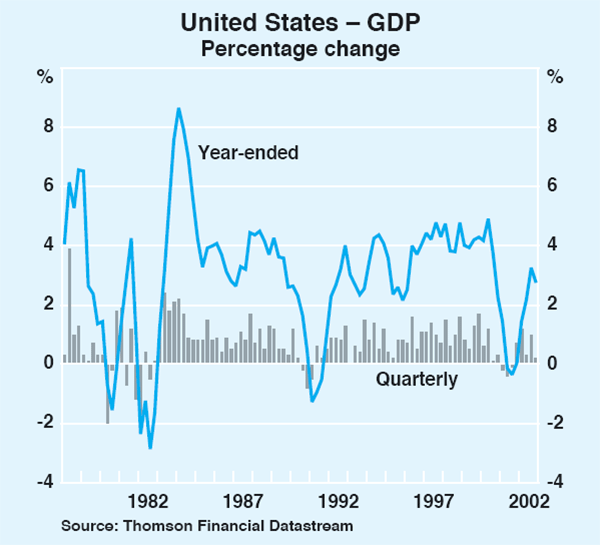
The main source of this volatility and of the slowdown in growth in the December quarter was household spending (Table 1). The weaker consumption growth towards the end of 2002 was especially marked for consumer durables, reflecting lower motor vehicle sales; abstracting from car sales removes much of the volatility. The slowdown in consumption growth is in line with the renewed weakness in the labour market. The unemployment rate rose back to 6 per cent in the quarter and non-farm payrolls fell significantly in both November and December, to be around the level recorded early in 2002 (Graph 2). A softer labour market and weaker equity prices are also likely to have affected sentiment. The Conference Board's measure of consumer confidence fell again in January, to around its lowest level in nine years. Notwithstanding these negative factors, growth in household disposable income has held up reasonably well, reflecting steady wages growth and tax cuts in mid 2001 and early 2002.
| September quarter 2002 | December quarter 2002 | Year to December 2002 | |
|---|---|---|---|
| Private consumption | 1.0 | 0.2 | 2.5 |
| Residential investment | 0.3 | 1.7 | 6.1 |
| Business investment | −0.2 | 0.4 | −1.9 |
| Public demand | 0.7 | 1.1 | 3.6 |
| Change in inventories(a) | 0.1 | −0.2 | 1.1 |
| Domestic demand | 1.0 | 0.3 | 3.4 |
| Net exports(a) | 0.0 | −0.2 | −0.9 |
| – Exports | 1.1 | −0.4 | 5.0 |
| – Imports | 0.8 | 0.9 | 9.2 |
| GDP | 1.0 | 0.2 | 2.8 |
|
(a) Contribution to GDP growth Source: Thomson Financial Datastream |
|||
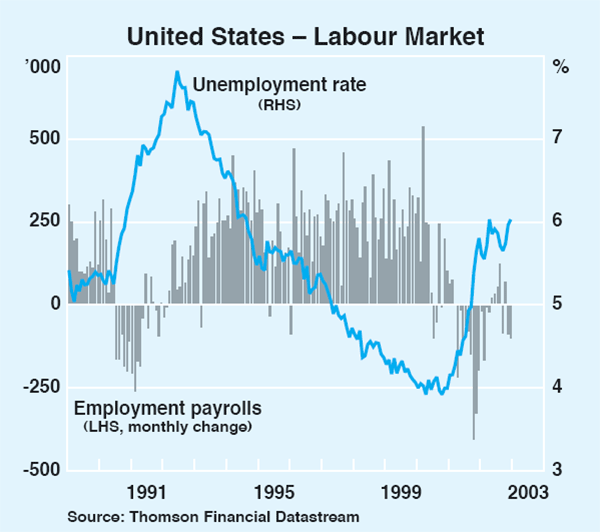
One area of relative strength in the US economy is the housing sector. Residential investment grew by 1.7 per cent in the December quarter, to be 6.1 per cent higher over the year. Dwelling starts and sales data from the end of last year remain at a high level, auguring well for activity in the beginning of 2003.
The robust rate of US household spending through most of last year underpinned a strong rise in US imports. Over the year to the December quarter, the volume of imports grew by 9.2 per cent. Growth in the volume of US exports has been lower over the same period, at 5.0 per cent. As a result of these trends, the external trade deficit increased further, to 4.3 per cent of GDP in the December quarter.
Indicators from the business sector generally suggest a continuation of soft conditions (Graph 3). Manufacturing output fell by 0.6 per cent in the December quarter, though the low level of the inventories-to-sales ratio suggests a rise in production is likely in the future. In contrast to the decline in production, the ISM survey of businesses provided a more upbeat assessment of conditions around the turn of the year, with particular strength in the new orders component. There are some signs that the decline in business investment has come to an end. After decreasing for eight consecutive quarters, business investment rose by 0.4 per cent in the December quarter. Spending on equipment has recorded small rises for the past three quarters but spending on structures has continued to decline.

Primarily reflecting rising energy costs, consumer price inflation in the past few months has risen to be just under 2½ per cent in year-ended terms. However, the core measure of inflation has continued to drift down, and at 2 per cent, is around ¾ of a percentage point lower than it was at the beginning of 2002. The divergence of inflation rates between prices of goods and services remains, with core services prices rising by 3½ per cent over the year to December and core goods prices falling by 1½ per cent. In line with softer labour market conditions, growth in labour compensation has continued to ease. The employment cost index increased by 0.7 per cent in the December quarter, reflecting slower growth in the wage component, to be 3.4 per cent higher than a year ago.
In response to the continued uncertainty over the prospects for recovery, the Bush Administration is proposing an additional fiscal package worth US$670 billion over a decade, of which US$100 billion (1 per cent of GDP) is planned over the next year. This is in addition to the sizeable fiscal boost to the economy over the past two years, and the substantial monetary stimulus, equivalent to a cumulative 525 basis points since the beginning of 2001 (see ‘Box A: US Macroeconomic Policy Developments’ for more details).
Asia-Pacific
Japan
After growing modestly in the first half of the year, activity in the Japanese economy stalled in the latter part of 2002, as the strong pick-up in exports evident earlier in the year levelled out (Graph 4). This was reflected in weaker industrial production in the December quarter, though the level of production remains nearly 6 per cent higher than a year ago. With limited momentum in domestic demand, the services sector, as measured by the Tertiary Activity Index, remained weak in the second half of 2002. In line with these trends, the December quarter Tankan survey showed weaker sentiment in the services sector.
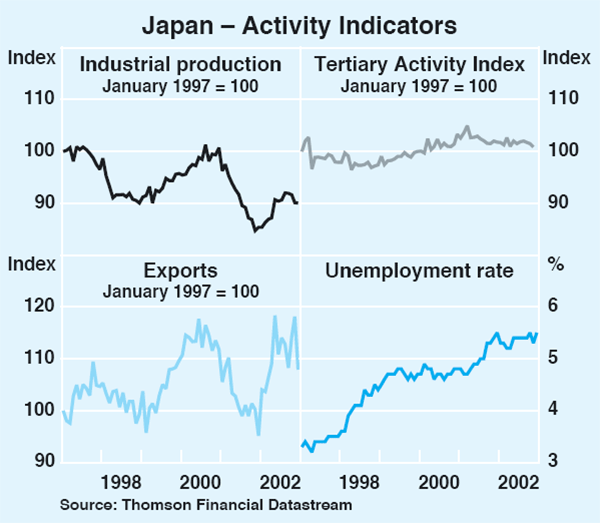
The weakness in those parts of the Japanese economy focused on domestic activity is consistent with difficult conditions in the household sector. Consumer confidence is well below long-run average levels, the unemployment rate has held close to the historical high of 5.5 per cent over the past six months or so, and employment resumed a downward trend in the latter part of the year, and is now nearly 2½ per cent lower than the most recent peak two years ago. In line with the weak labour market, earnings have continued to fall. Prices have fallen by around 3 per cent over the past five years and by 0.2 per cent over the year to December (Graph 5).
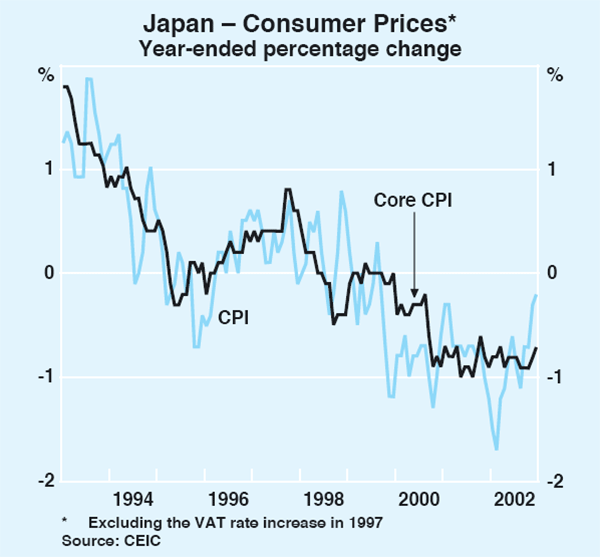
Non-Japan Asia
Non-Japan Asia was one area of relative economic strength through much of last year. But towards the end of 2002 the rate of growth for the area as a whole appears to have slowed. There was also a moderation in export growth, which was concentrated among intra-regional exports; exports to countries outside the region have continued to grow strongly (Graph 6). Divergent trends between economies in the region also became more apparent over the latter part of last year (Table 2). While China and Korea continued to perform well, with production and exports remaining strong, industrial production in Malaysia and Taiwan stabilised and conditions in Singapore deteriorated. Consistent with ongoing strong productivity gains in China and surplus capacity in Hong Kong, prices continue to decline in year-ended terms, while in Singapore and Taiwan inflation is currently just above zero, following declining prices through most of 2002.
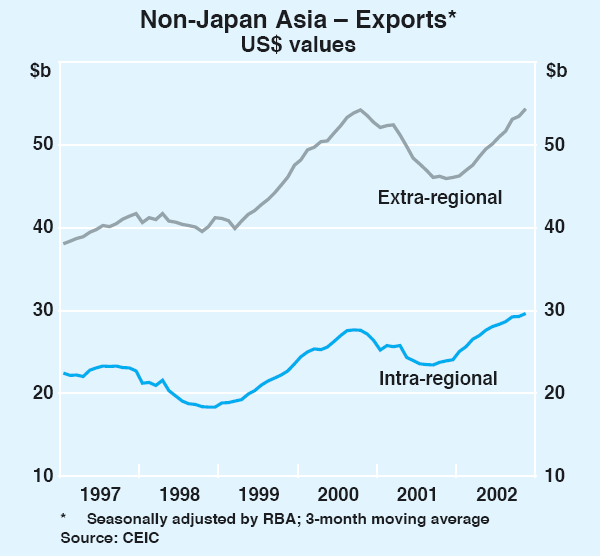
| Industrial production | Exports | Inflation | |
|---|---|---|---|
| Latest three months on previous | Year to latest | ||
| China | 5.2 | 4.6 | −0.4 |
| Hong Kong | −1.6 | −6.1 | −1.6 |
| India | 0.8 | 0.8 | 3.4 |
| Indonesia | – | 1.5 | 8.7 |
| Korea | 3.1 | 5.1 | 3.8 |
| Malaysia | 1.2 | −1.3 | 1.7 |
| Philippines | 0.4 | −1.8 | 2.7 |
| Singapore | −3.2 | −1.8 | 0.4 |
| Taiwan | 0.0 | 0.6 | 0.8 |
| Thailand | 2.0 | 0.7 | 2.2 |
|
Source: CEIC |
|||
The New Zealand economy grew by 1.0 per cent in the September quarter and by 4.6 per cent over the year. Growth was supported by domestic demand, with higher household expenditure on consumer items and new housing construction and a build-up of inventories more than offsetting a contraction in exports. Year-ended inflation in the December quarter, at 2.7 per cent, remains towards the top of the Reserve Bank of New Zealand's target band.
Europe
For some time now the euro area economy has been growing at a rate well below potential. GDP in the euro area barely increased in the September quarter, to be 0.8 per cent higher than a year earlier. Much of the growth over the year relied on a pick-up in exports, as domestic demand remained subdued, though in the September quarter there were some signs of a more evenly balanced composition of growth. These aggregate developments mask diverse cyclical positions among the euro area countries. While many of the smaller euro area economies have recorded reasonable growth outcomes, the German economy has continued to stagnate. German output is estimated to have risen by just 0.2 per cent in 2002, implying broadly flat output in the December quarter. Indicators suggest that industrial output growth in Italy and France was also weak in the latter part of 2002.
Euro area consumer confidence has declined for several months now, to reach a five-year low (Graph 7). Business sentiment surveys in all the euro area countries except France also weakened towards the end of last year, although the European Commission area-wide measure has remained relatively stable. Notwithstanding slow growth, the labour market has remained resilient, with the unemployment rate in December only 0.5 percentage points above its trough in 2001, at 8.5 per cent. Year-ended employment growth has slowed in all the large euro area economies, especially in Germany, where the number of employees has declined for the past 12 months.
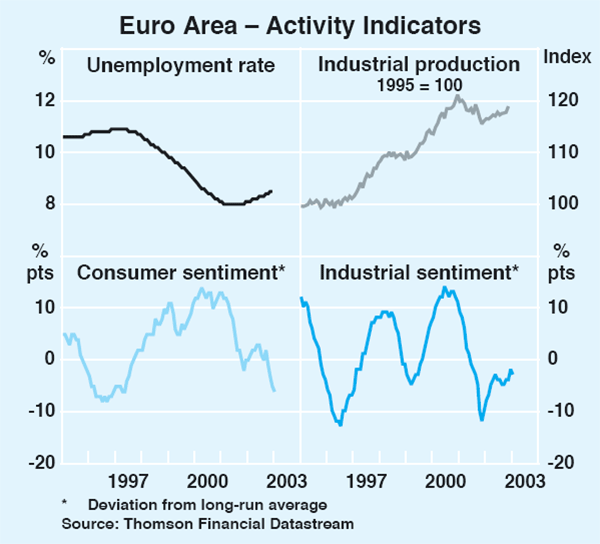
Higher oil prices contributed to volatility in consumer price inflation over the past year. However, core consumer price inflation, which excludes oil, has remained broadly steady at around 2¼ per cent over the year to December (Graph 8). Reflecting the lack of inflationary pressures and sluggish economic activity, the ECB cut its policy rate by 50 basis points in December. But despite the weak economic growth, the scope for discretionary expansionary fiscal policy is curtailed in a number of euro area countries because fiscal balances are already close to, or in breach of, the limits set by the Stability and Growth Pact.
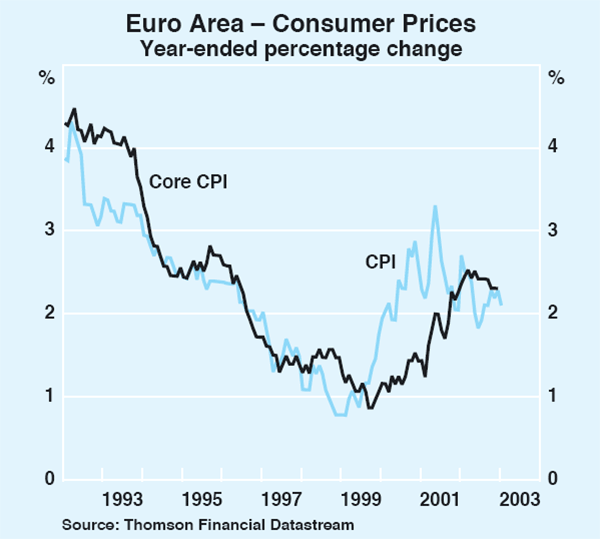
Growth slowed towards the end of 2002 in the United Kingdom, with GDP expanding by 0.4 per cent in the December quarter, to be 2.2 per cent higher over the year. Divergent trends in the manufacturing and service sectors, evident for several years now, continued in the December quarter, with manufacturing activity declining while growth in services output remained strong. Continued strong consumption growth has been underpinned by solid labour market outcomes – with unemployment falling further in the second half of 2002 to historically low levels – as well as by higher house prices and low interest rates, spurring greater borrowing against rising house values. Year-ended inflation (excluding mortgage interest payments) rose to 2¾ per cent in December, from around 2 per cent in the middle of last year. Fiscal policy is expected to be expansionary both this year and next year, and follows a stimulus equivalent to nearly 2 percentage points of GDP in 2002.
Oil price developments
Oil prices have risen sharply since the beginning of December, though they remain below the peaks reached around the time of the Gulf war (Graph 9). The rise in oil prices has primarily reflected the general strike in Venezuela, the world's fifth largest oil exporter, and the tensions in the Middle East. With the price of crude oil above the upper end of the OPEC target price range, OPEC members decided in mid January to raise official production quota levels by 1.5 million barrels per day from the beginning of February, although this announcement had little effect on prices.
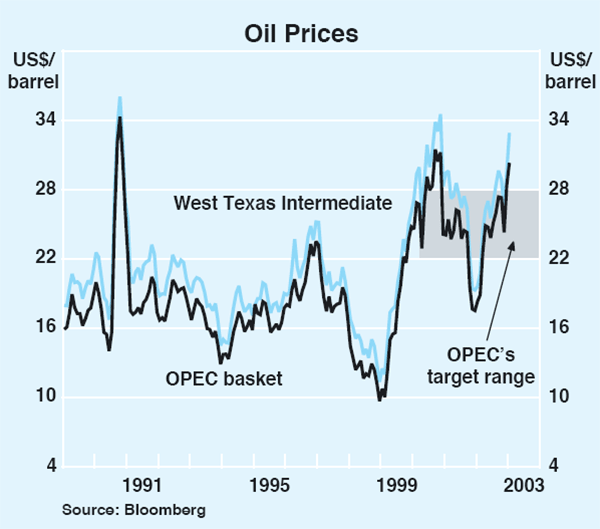
If these higher oil prices are sustained for an extended period, world output growth would be adversely affected and inflation would be higher. IMF estimates suggest that a sustained increase in the oil price of US$5 per barrel would reduce world growth by at least 0.3 percentage points in the following year or so. There is more variation in the impact on inflation across countries: the IMF estimates the rise would be greatest in the US, reflecting its high energy intensity of production, while in Japan a more subdued impact is likely. (For more details on the effect of oil prices on the world economy, see Box A in the November 2000 Statement of Monetary Policy.)
Box A: US Macroeconomic Policy Developments
There has been a substantial easing of both monetary and fiscal policy in the US over the past two years in response to the recent recession. Since the beginning of 2001, the Fed funds rate has been reduced by a total of 525 basis points (Graph A) and expansionary fiscal packages were enacted in 2001 and 2002, with a further package currently before the US Congress. In the case of fiscal policy, the easing was both earlier and larger than in previous recessions; in the case of monetary policy, the easing may not have started earlier, but the speed of the interest rate reductions was much faster than in the previous recession.
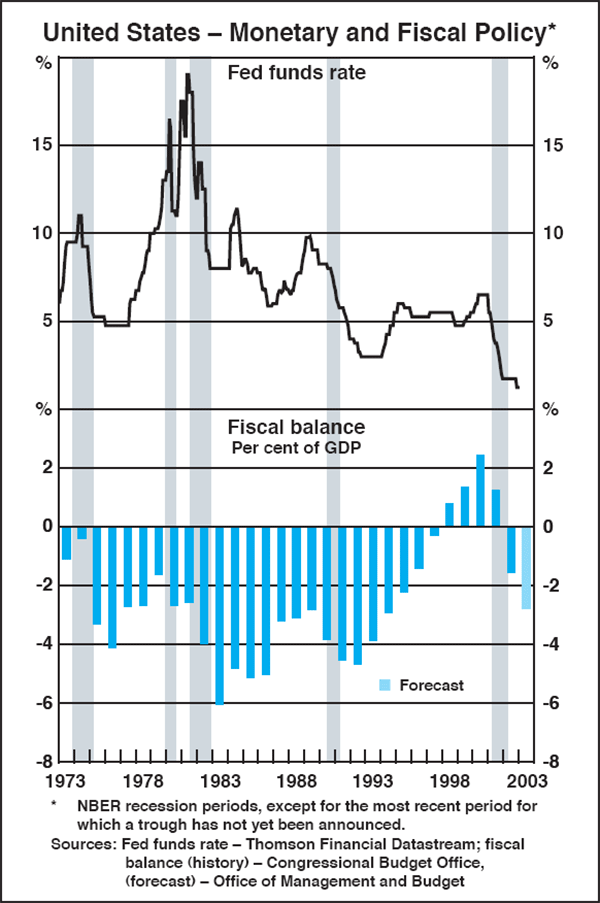
The easing in monetary policy commenced in January 2001, slightly ahead of the peak in economic activity, which the NBER dates as occurring in March 2001. This was not as early in the business cycle as it was in the early 1990s' recession, but the overall change in the stance of policy was more decisive on this occasion. Most of the easing in monetary policy in the current cycle occurred during 2001 and, by late 2001, the Fed funds rate was at its lowest level in 40 years. Following a pause of almost a year, the Fed eased by another 50 basis points late in 2002, which took the Fed funds rate to 1¼ per cent.
The change in the fiscal balance (an approximate measure of the boost to the economy from fiscal policy) from 2000 to 2002 has totalled nearly 4 per cent of GDP, as the balance has moved from a surplus of 2.4 per cent of GDP in 2000 to a deficit of 1.5 per cent of GDP in 2002.[1] According to the Congressional Budget Office, around half of this change in the fiscal balance has resulted from the automatic response of the budget to the weaker economy. Most of this was due to lower revenues as individual and corporate income taxes and capital gains tax receipts were all significantly lower in the past two years. The other half has resulted from discretionary measures taken by the Bush administration, primarily reflecting the 2001 tax cuts, the worker-assistance package in 2002 and the emergency assistance provided following the September 2001 terrorist attacks. In contrast to earlier downturns, the timing of the discretionary measures was not subject to significant lags; for example, tax rebates commenced relatively soon after the peak in the economy in March 2001.
In response to the continued uncertainty over the prospects for recovery, the Bush administration is proposing an additional fiscal package worth US$670 billion over the next 10 years, of which US$100 billion (1 per cent of GDP) is planned over the next 12 months. The package includes: continuing funding for the extension of unemployment benefits (which has already been enacted); bringing forward the reductions in income tax rates that were due to be implemented in 2004 and 2006, with these to take effect retroactively from 1 January this year; eliminating the double taxation of dividends; tripling the value of equipment investment that businesses can write off each year as expenses; and financing job retraining and support programs.
International and Foreign Exchange Markets
Short-term interest rates
Reflecting the possible stalling in economic growth noted in the previous chapter, central banks in the US and the euro area resumed easing monetary policy towards the end of 2002. The Fed cut rates by 50 basis points, to 1.25 per cent, in November and the European Central Bank cut by 50 points, to 2.75 per cent, in December.
The current level of policy rates in the US is unusually low – the lowest since the early 1960s. Nonetheless, markets are starting to price in the possibility of further rate cuts by the US Fed, amid concerns that economic weakness in the US could persist longer than earlier thought (Graph 10).
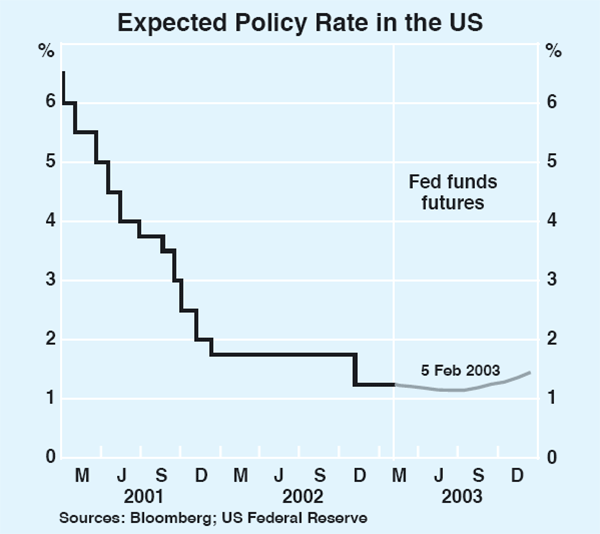
The level of policy rates in the euro area is also relatively low, though the period to which one must look to find similarly low rates in Europe (Germany) is only October 1999. Financial markets are very strongly of the view that there will be rate cuts in Europe in the months ahead.
Outside the euro area, a couple of other European countries have also cut rates recently (Table 3). Sweden cut rates by 50 points over the December quarter, to 3.75 per cent. It had been one of the countries raising rates in the first half of last year, but the recent change in the international economic outlook and in its domestic inflation outlook was enough to cause it to change direction. Norway, which had also raised rates in the first half of 2002, cut rates by 50 points in both December and January.
| Current level Per cent | Cumulative reductions in down cycle |
Changes in policy rates |
||
|---|---|---|---|---|
| Jan–Jul 2002 | Since Aug 2002 | |||
| US | 1.25 | −525 | −50 | |
| Canada | 2.75 | −375 | 50 | |
| Switzerland | 0.75 | −275 | −100 | |
| UK | 4.00 | −200 | ||
| Australia | 4.75 | −200 | 50 | |
| NZ | 5.75 | −175 | 100 | |
| Euro area | 2.75 | −200 | −50 | |
| Sweden | 3.75 | −50 | 50 | −50 |
| Norway | 6.00 | −100 | 50 | −100 |
| Japan | 0.00 | −25 | ||
|
Sources: Central banks |
||||
Among the other developed economies, official rates have been held steady since around the middle of last year (Graph 11). In most cases these countries had been raising rates in the first half of 2002, as their economic activity returned to normal rates of expansion, but they subsequently paused as international uncertainty grew. Among this group, Canada, which still has relatively low interest rates (2.75 per cent) has recently signalled that it may need to raise rates further if the strength of its domestic economy continues. Others, however, seem to be closer to easing. In the UK, some members of the Monetary Policy Committee have been voting in favour of a cut for some months now, while in New Zealand, which has relatively high interest rates and a sharply appreciating exchange rate, the central bank has signalled that it may ease if current trends continue.
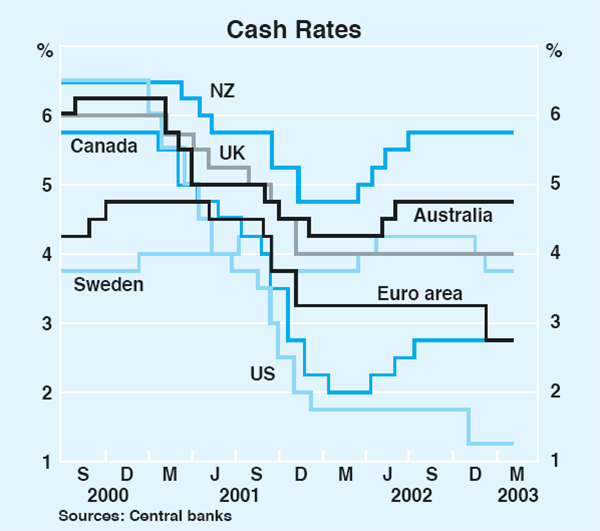
Among emerging market economies, a clear distinction can be drawn between Asia and Latin America. Official interest rates in Asia are for the most part at low levels and recent moves have all been in the downward direction. The central banks in Hong Kong, Indonesia, Taiwan and Thailand all cut rates in recent months. In Latin America, in contrast, interest rates are at high levels in the main economies (20–25 per cent) due to continuing economic difficulties. In the case of Argentina, these levels are well down on those reached in the peak of the crisis a year ago, though Brazil has raised its official rates by about 750 basis points over the past few months as the central bank tries to quell resurgent inflation.
Long-term interest rates
Global long-term interest rates are again falling after having stabilised for a while in late 2002. In the US, for example, after the Fed cut official rates in November, 10-year bond yields rose to 4.25 per cent, as the share market recovered and sentiment about the economy more generally improved. But, in recent weeks, yields have fallen back below 4 per cent (Graph 12). While this is still above the low-point of 3.57 per cent last October, when economic pessimism was at its peak, it is down by about 110 basis points from a year earlier. This is a large fall in bond yields and gives some indication of the extent to which economic sentiment deteriorated through 2002. The fall in yields has reflected not so much a reduction in inflation expectations, but a fall in real yields, as indicated by indexed bonds. Yields on 10-year indexed bonds are now around 1.9 per cent, less than half the level at their peak in early 2000 and the lowest reading since indexed bonds were introduced in the mid 1990s.
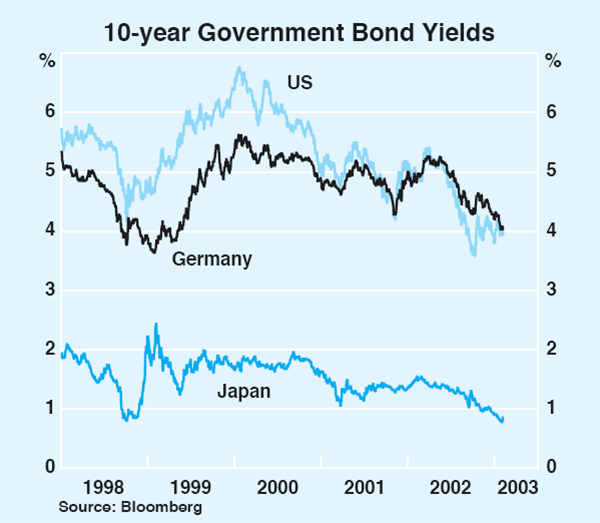
European long-term interest rates did not fall as much as those in the US in the second half of 2002 as the downward revisions to the US growth outlook, for a time, were more pronounced. As such, by the end of that year European yields were 40 basis points higher than corresponding US yields, whereas at the start of the year the level had been fairly similar in both regions. More recently, however, with market analysts being surprised by the weakness in European growth, long-term yields in that region have fallen quite sharply and the gap between US and European yields has narrowed again to a few basis points.
In Japan, bond yields have been on a steady downward trend since early 2002 as markets increasingly came to the view that the economic recovery would be anaemic. The yield on 10-year government bonds fell to an historical low of 0.76 per cent in late January.
Spreads between US corporate bonds and Treasuries have narrowed significantly in recent months from their previously elevated levels. The easing is noticeable across all of the credit ratings, with the spread between ‘junk’ bonds and Treasuries falling from a peak of about 900 basis points in October to around 630 basis points now; that on A-rated paper has fallen from 200 points to 120 points (Graph 13). These falls have seen spreads narrow to levels that prevailed before the 2001 recession in the US. Normally such a narrowing in spreads could be taken as a sign of a significant decline in risk aversion in markets, but on this occasion such an assessment does not seem consistent with other developments in markets, such as the nervousness pervading share markets. In part, the narrowing in spreads probably reflects the passing of the extreme uncertainty that gripped markets last year after a few high profile corporate collapses, but it also probably reflects the tendency of investors to chase relatively high yields in a generally low-yield environment. In 2000, for example, if yields on BBB-rated US corporate bonds were expressed as a ratio of yields on US Treasuries, they averaged around 40 per cent higher; by late 2002, they reached 100 per cent higher, a relativity not seen since the early 1940s. Such a large gap may have encouraged some investors to the view that the premium for credit risk was attractive given the rates on offer elsewhere.
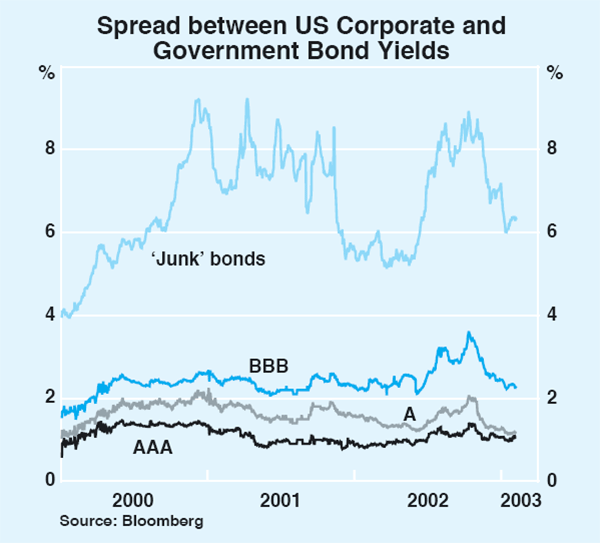
Spreads on emerging market sovereign debt have narrowed by around 120 basis points over the past three months, reflecting improved perceptions of sovereign risk in both Latin America and the emerging European economies. Spreads on Asian sovereign debt also narrowed, and remain at much lower levels than in the other two regions (Graph 14).
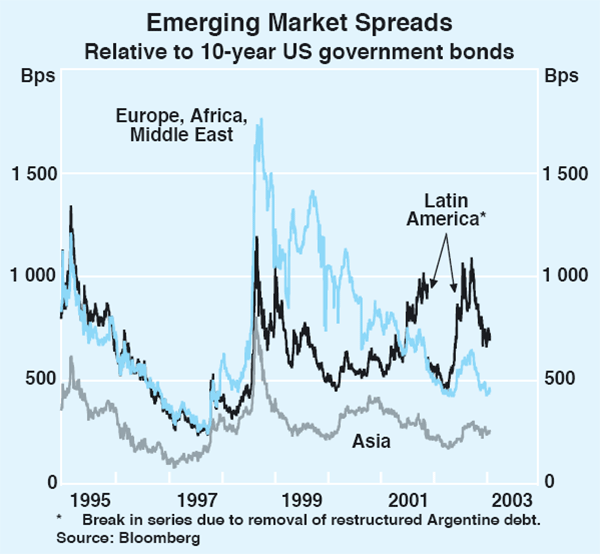
Equity markets
Equity markets seemed to get a boost in late 2002 both by the anticipation and the announcement of the Fed easing. Some commentators came to the view that the market had finally bottomed. By December, however, the upward move in share prices was starting to lose momentum and, in the past month or so, equity prices around the world have been falling noticeably again (Graph 15, Table 4). The main factor in this renewed weakness is the disappointing run of economic data and corporate profit announcements, though uncertainty about the likely conflict with Iraq may also have made investors more cautious.
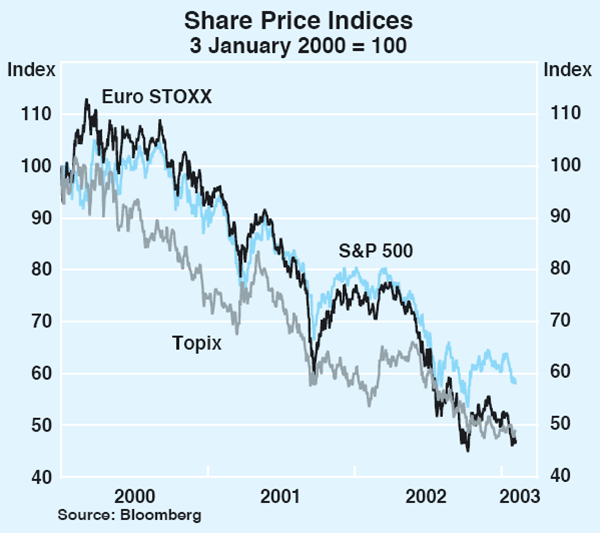
| Change since 2000 peak |
Change over 2001 |
Change over 2002 |
Change in 2003 |
|
|---|---|---|---|---|
| United States | ||||
| – Wilshire | −46 | −12 | −22 | −4 |
| – Dow Jones | −32 | −7 | −17 | −4 |
| – S&P 500 | −45 | −13 | −23 | −4 |
| – NASDAQ | −74 | −21 | −32 | −3 |
| Euro area | ||||
| – STOXX | −58 | −20 | −35 | −6 |
| United Kingdom | ||||
| – FTSE | −47 | −16 | −24 | −7 |
| Japan | ||||
| – TOPIX | −52 | −20 | −18 | 0 |
| Canada | ||||
| – TSE 300 | −43 | −14 | −14 | −1 |
|
Source: Bloomberg |
||||
In 2002, broad stock indices in the major markets recorded their third consecutive annual decline, for the first time since 1939–41 in the US and since 1929–31 in Germany. While the broad-based Japanese indices have also fallen for three consecutive years, this continues the trend seen since the bubble burst in 1989, with the Topix falling in 9 of the 13 years since then.
After three years of falls accumulating to 40–60 per cent, history would suggest that share prices were at or near their bottom. There has only been one occasion in the past 130 years in the US when share prices have fallen for four years in a row; that was during the Depression years. Yet on various methods of valuation, share prices still look high compared with historical norms. For example, the P/E ratio for the S&P 500 remains around 27, which is around twice the long-run average (Graph 16). Similarly, the ratio of share market capitalisation to GDP in the US also remains higher than normal. It seems that share markets are continuing to overestimate rates of growth of nominal GDP, and therefore corporate profitability. Even though real GDP growth over the past couple of years has held up better than in the recession of the early 1990s, this is not the case for nominal GDP, which for share markets is more relevant than real GDP. In 2001, nominal GDP growth was only half that seen in 1991 and even though there was a pick-up in nominal GDP growth in 2002, the growth rate remained around that seen in 1991. In this environment, it is not surprising that analysts' expectations of corporate profits have been overly optimistic. The National Accounts measure of net corporate profits in fact fell in the first three quarters of 2002 (the latest period for which data are available) and the level of profits is only about the same as in 1996 (Graph 17).
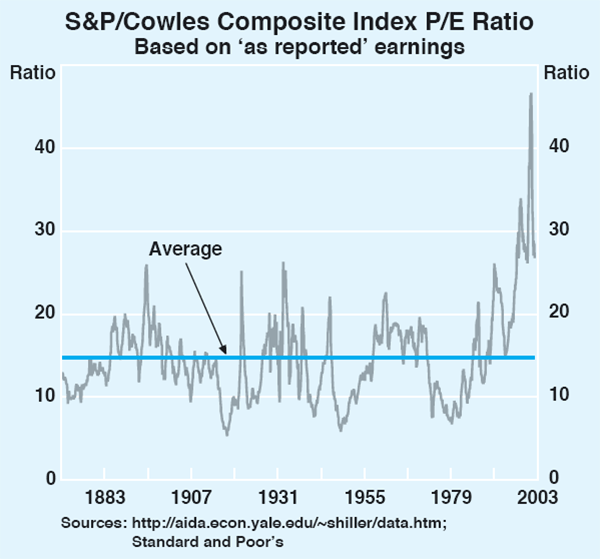
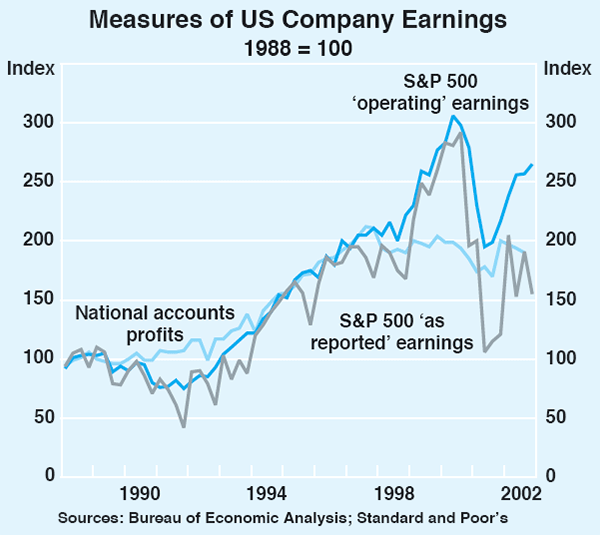
As in the US, European equity markets have fallen recently, as continued uncertainty surrounding both the economic outlook and developments in the Middle East weigh on investor confidence (Graph 15). While much of the weakness seen in European equities over the course of 2002 was driven by concerns in the banking and finance sectors, these sectors recovered in the later stages of 2002 and have generally performed in line with the broad market over recent months. The recent weakness appears to be driven by a re-evaluation of the cyclical economic prospects, with the retail and consumer sectors particularly hard hit. At the same time, rising oil prices have impacted negatively on the chemicals and pharmaceuticals sectors.
In Japan, equity markets remain weak. Although the major indices appear to have stabilised somewhat after the steady declines seen over the second half of 2002, they remain near the 18-year lows seen in December 2002 (Graph 15). The Bank of Japan commenced stock purchases from banks in early December and by late January had purchased around ¥380 billion (out of its announced program of ¥2 trillion).
In the Asian emerging markets, stock markets have fallen slightly on average since the last Statement, although this reflected a mixed performance across the region. The Taiwanese equity market performed best, with prices up 10 per cent, followed by an increase of 6 per cent in Indonesia. These gains were offset by declines of 12 per cent in Singapore, 9 per cent in Korea, and 3 per cent in Hong Kong. In contrast to other markets, share prices in Latin America generally rebounded strongly over the past three months. The Argentinean stock index increased by 30 per cent over this period, while stock indices in Chile and Peru each rose by more than 20 per cent.
Exchange rates
A significant development in international financial markets over recent months has been the resumption of the depreciation of the US dollar. In trade-weighted terms, it has now fallen 13½ per cent from its early 2002 peak with about half that fall coming in the past few months (Graph 18). The recent decline has been attributed to various specific factors, including heightened concerns about the sustainability of the US's current account deficit, the anaemic economic recovery and concerns about the potential impact of any war in Iraq. More generally, however, it appears that interest rate differentials are again emerging as an important influence on exchange rates. This is in contrast to the second half of the 1990s and into 2000, when equity investment was important in global capital flows and the impact of interest rate differentials on exchange rates seemed to diminish.
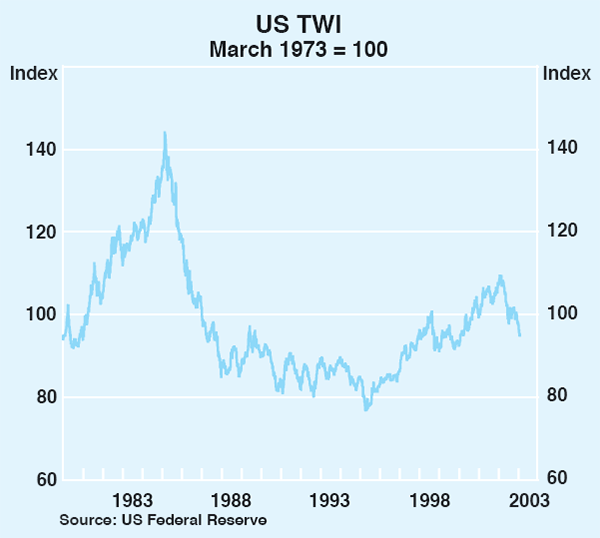
The decline in the US dollar has been broadly based, with falls of 2 per cent against the yen, 8 per cent against the euro and Swiss franc, and 4½ per cent against the pound since the end of October (Table 5).
| Change since end October |
|
|---|---|
| Canadian dollar | −2.5 |
| Euro | −8.2 |
| Yen | −2.0 |
| Pound sterling | −4.6 |
| Swiss franc | −7.9 |
| Swedish krona | −6.5 |
|
Source: RBA |
|
The euro, on the other hand, appears to have been independently strong, appreciating against all major currencies. From its October 2000 trough, it is now up about 22 per cent in trade-weighted terms and about 30 per cent bilaterally against the US dollar.
Outside Europe, one of the strongest currencies has been the New Zealand dollar, which has risen to a three-year high of 0.55 against the US dollar. It has also risen strongly against the Australian dollar, with the bilateral rate appreciating to 1.076 from 1.13 at end November.
Asian currencies have not risen as much as some others against the US dollar over recent months, continuing their more stable relationship over recent years. Latin American currencies were also flat on average against the US dollar, with an 11 per cent rise in the Argentine peso offset by a 26 per cent fall in the Venezuelan bolivar.
Australian dollar
The Australian dollar has strengthened against the generally weakening US dollar over the past few months, particularly in January when it rose 5 per cent. The exchange rate is currently around US59 cents, its highest level against the US currency since August 2000 (Graph 19). Since the lows reached in April 2001, the exchange rate has appreciated by 23 per cent against the US dollar.
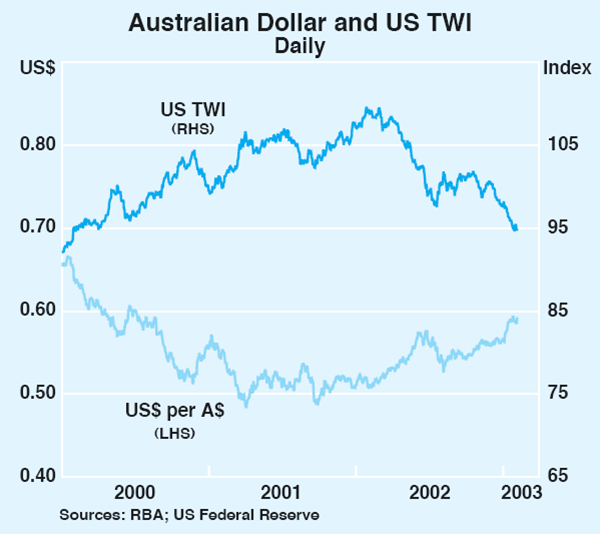
The picture in trade-weighted terms is, however, very different as the recent strength of the Australian dollar against the US dollar is in large part due to the latter's weakness. The TWI has risen only 2½ per cent since the end of November 2002 (Graph 20). The rise against the US dollar has been offset by falls against the euro, pound, Swiss franc, Swedish krona and the New Zealand dollar (Table 6). The current level of the TWI (53.5) remains below that of mid 2002.

| Since end November 2002 | Since end December 2001 | |
|---|---|---|
| Philippines | 6.4 | 21.3 |
| United States | 5.7 | 16.1 |
| Taiwan | 5.4 | 15.1 |
| Indonesia | 4.4 | −1.1 |
| Singapore | 4.2 | 9.0 |
| Thailand | 4.0 | 12.2 |
| Japan | 3.4 | 5.8 |
| South Korea | 2.8 | 3.4 |
| Canada | 1.8 | 10.6 |
| United Kingdom | −0.7 | 2.1 |
| Sweden | −1.7 | −6.0 |
| Euro area | −3.5 | −5.5 |
| Switzerland | −4.2 | −6.5 |
| New Zealand | −4.8 | −12.4 |
| TWI | 2.5 | 6.6 |
|
Source: RBA |
||
Demand for Australian assets from Japan has been very strong, reflected in record amounts of uridashi issuance ($6.2 billion during January and early February) (Graph 21). Short-term speculative positions on the Chicago futures exchange have also moved long, as they did in early 2002 when the market was rising (Graph 22).

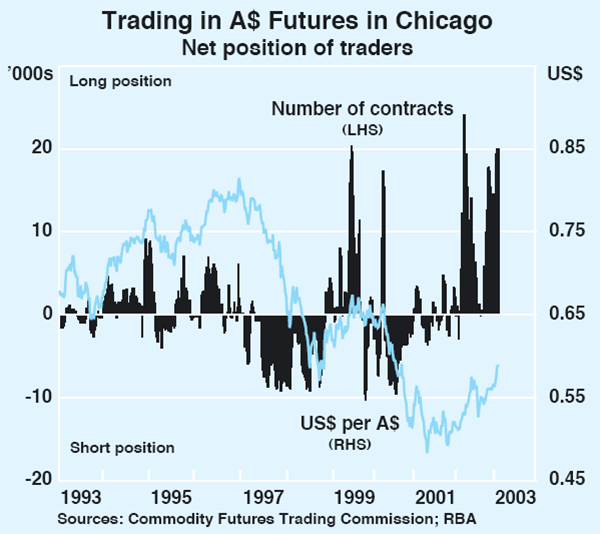
Taking a longer-term view of the exchange rate, the current level of the TWI (the most appropriate measure to look at) is marginally below the long-term average. Since the mid 1980s depreciation, the TWI has been within a band between 49 and 62 for most of the time, with an average of 55.5. It is now about 3½ per cent below that average (Graph 23).
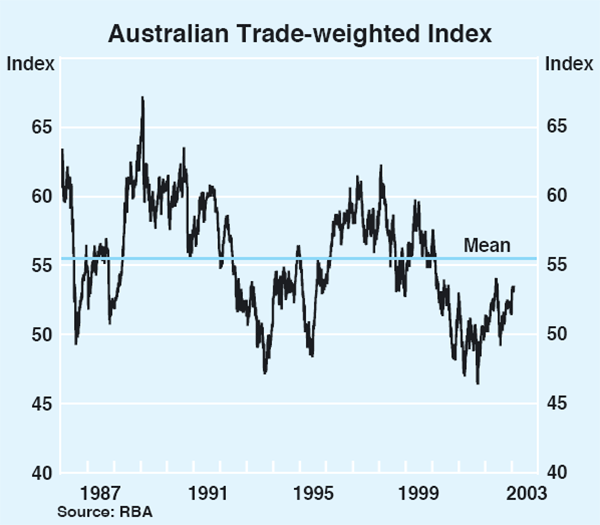
The Bank's market and other purchases of foreign currency in recent months have more than covered the Government's requirements. There have been net purchases of some $960 million over the past three months. Earnings on foreign reserves added a further $490 million over this period, but valuation effects reduced reserves by around $400 million. Net reserves currently stand at $12.1 billion, up from $7 billion this time last year. Foreign currency swaps outstanding have declined a little recently as, for liquidity management reasons, the Bank has repaid some swaps. Swaps outstanding at end January were $24 billion, down $2.2 billion over the past three months and around $5.6 billion over the past year. Gross reserves – i.e. net reserves plus foreign currency held under swaps – were $36 billion at the end of January, about the same as a year earlier.
Domestic Economic Activity
According to the latest national accounts, real GDP rose by 0.9 per cent in the September quarter, to be 3.7 per cent higher than a year earlier (Table 7). Growth in domestic final demand was particularly strong, increasing by around 6 per cent over the year, reflecting solid growth in consumer spending coupled with the continued upswing in housing activity and a recovery in business investment. A marked divergence between domestic and external demand remains a feature of Australia's recent economic performance (Graph 24). Some of the growth in domestic demand has been met by a sharp rise in import volumes, which, together with a fall in export volumes owing to subdued external demand, has resulted in net exports subtracting around 3 percentage points from growth in GDP over the year to the September quarter. The first noticeable effects of the drought on agricultural production were also evident in the quarter, with farm GDP subtracting 0.4 percentage points from overall output growth.
| September quarter 2002 |
Year-ended September quarter 2002 |
|
|---|---|---|
| Private final demand(a) | 0.9 | 6.7 |
| Consumption | 0.4 | 4.2 |
| Dwelling investment | 3.3 | 22.5 |
| Business investment(a) | 2.6 | 13.0 |
| Public final demand(a) | −0.2 | 4.3 |
| Domestic final demand | 0.7 | 6.1 |
| Change in inventories(b) | 0.2 | 0.1 |
| Exports | −0.7 | −1.0 |
| Imports | 0.8 | 13.4 |
| Net exports(b) | −0.3 | −3.1 |
| Gross domestic product | 0.9 | 3.7 |
|
(a) Excluding the effect of transfers between the private and other sectors Source: ABS |
||
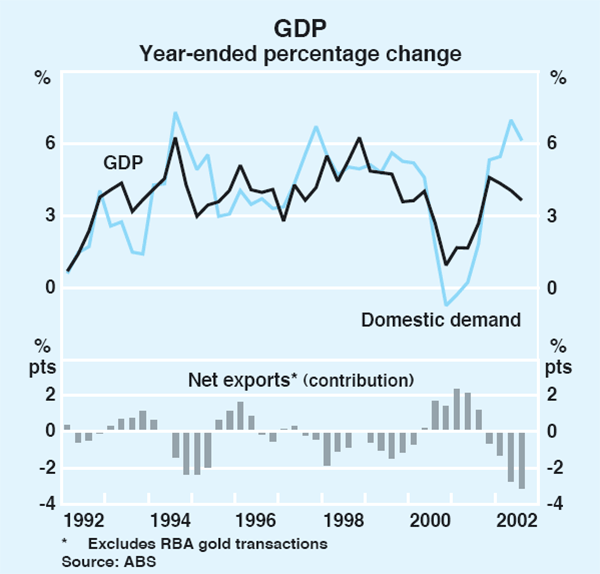
Some slowing in output growth is expected in coming quarters as the full force of the drought is felt. Output of the farm sector, which typically accounts for about 3 per cent of total production, is projected to fall by about one-third over the year to the June quarter. This will also have an adverse effect on other parts of the economy with strong linkages to agriculture. The outlook for the rest of the economy, however, remains positive. Forward indicators suggest that activity in the dwelling sector will peak around the middle of the year, but other sources of demand should remain solid. Conditions in the non-farm business sector remain quite positive, with most measures of business confidence at levels typically associated with around trend growth in output. Capital expenditure intentions and the large number of non-residential construction projects in the pipeline indicate that the strong growth in business investment over the past year should continue in the period ahead. Consumption should remain supported by favourable conditions in the labour market, though employment growth is likely to moderate from its current rapid pace.
Household consumption
Growth in household spending eased back towards more sustainable levels in the second half of 2002, with retail sales volumes growing at an annualised rate of 3 per cent over this period, compared with 8 per cent over the first half of the year (Graph 25). The strength in consumer spending over 2002 has largely been in discretionary items, with the volume of sales at clothing and soft goods retailers rising by 10 per cent over the year. Growth in sales of household goods eased in the second half of the year, though sales remain at a high level, underpinned by the strength in dwelling investment. Household spending on motor vehicles fell towards the end of the year, though this followed a period of very strong sales.
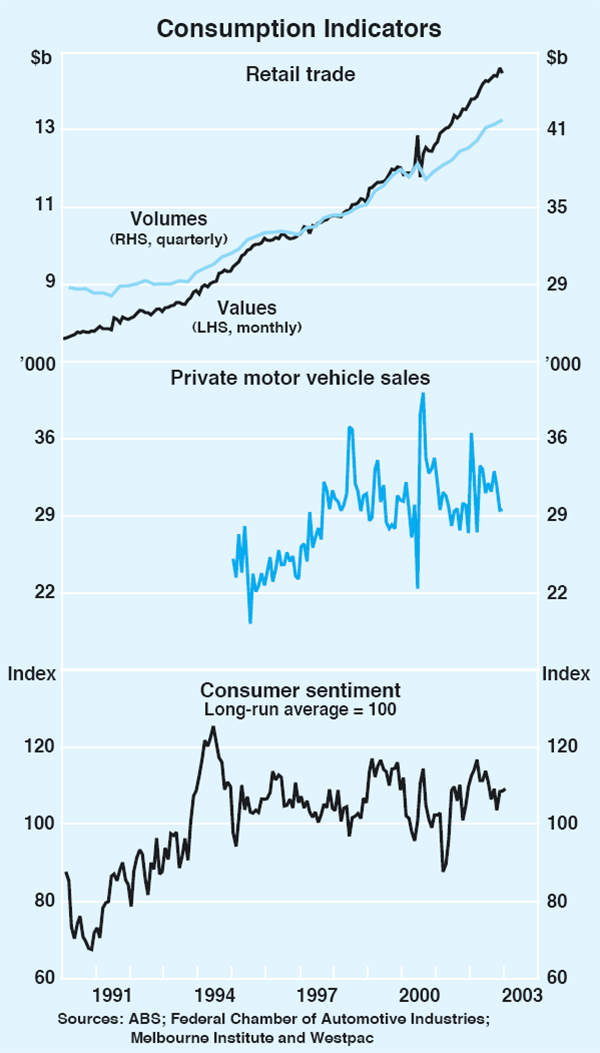
Further solid growth in consumption seems likely in view of the strong growth in employment, which should continue to support household incomes. The Westpac-Melbourne Institute index of consumer sentiment remains well above its long-run average level, though it has eased from the very high levels recorded in the first half of 2002. The latter reflects a trend that is also evident in the business sector, with the indices of sentiment relating to an individual's situation remaining above their long-run average levels, while views about general economic conditions have tended to become less optimistic over the course of 2002.
Consumer spending also continues to be supported by increases in the value of household assets and increased borrowing. The value of household assets rose by 14½ per cent over the year to the September quarter, largely reflecting strong gains in dwelling prices (Table 8). The rising value of household assets, together with the low cost of borrowing, have contributed to a rapid increase in household borrowing, with credit to households increasing by 18 per cent over the year to December 2002. While most of the recent strength in household borrowing has been for the financing of house purchases, it is likely that some of the rise in mortgage-secured borrowing has been directed towards consumption.
| Level | Share of total | Annual growth Per cent | ||
|---|---|---|---|---|
| $ billion | Per cent | Year to Sep 2002 |
Average Sep 1996–Sep 2001 |
|
| Housing | 2,085 | 62.4 | 21.9 | 12.2 |
| Consumer durables | 191 | 5.7 | 9.7 | 6.0 |
| Financial assets | 1,068 | 31.9 | 3.1 | 9.7 |
| – Superannuation and life offices | 506 | 15.1 | 0.0 | 11.5 |
| – Equities and unit trusts | 221 | 6.6 | 2.5 | 13.6 |
| – Currency and deposits | 303 | 9.1 | 10.9 | 6.6 |
| – Other | 38 | 1.1 | −7.5 | −2.6 |
| Total | 3,344 | 100.0 | 14.5 | 10.9 |
|
(a) Includes unincorporated sector and excludes unfunded superannuation and prepayment of insurance Sources: ABS; RBA |
||||
Reflecting the strong growth in borrowing over the past few years, household debt has increased from around 80 per cent of household disposable income in 1997 to 122 per cent currently (Graph 26). An alternative indicator of household gearing is the ratio of household debt to household assets. This ratio has also risen over the same period, but by considerably less, reflecting the concurrent strong increases in house prices, and currently is around 15 per cent (Graph 27).
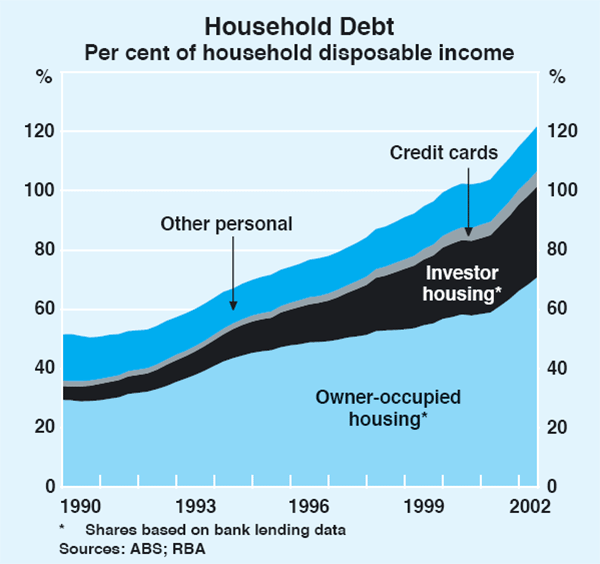
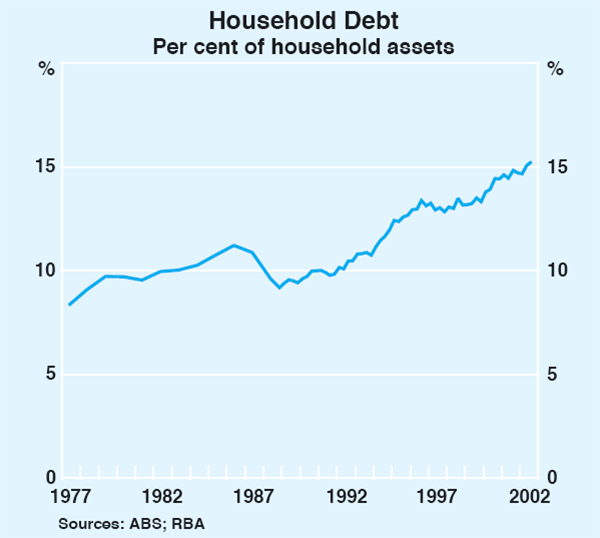
Borrowing secured against housing has accounted for nearly all of the increase in household debt since 1997. An unusual feature of this period is that the rise was split more evenly between lending to owner-occupiers and lending to investors than in earlier periods. Lending to investors has increased at an annual rate of around 21 per cent since mid 1997, compared with a rate of 13 per cent for lending for owner-occupation. Despite having grown rapidly over the past five years, credit card debt has accounted for only a small part of the rise in debt given its small share of total household debt. Some of the growth in household debt reflects an increase in the number of borrowers, as the shift to a low inflation/low interest rate environment has broadened the availability of credit to households. However, much of the increase relates to an increase in the average size of borrowing, which has been associated with rising house prices: the average size of a new housing loan approval for owner-occupation has risen from $118,000 in 1997 to $175,000 in 2002.
Housing
Dwelling investment has continued growing apace, rising by a further 3 per cent in the September quarter, to be 23 per cent higher than a year earlier. Much of the growth has been in the construction of new dwellings, but spending on alterations and additions, which accounts for more than 40 per cent of dwelling investment, has also experienced a rapid pick-up in the last couple of quarters to be 16 per cent higher over the year.
Dwelling commencements and the stock of work outstanding continued to rise in the September quarter, indicating further near-term growth in dwelling investment. Further out, however, some fall in housing activity is likely, with the value of owner-occupier housing loan approvals for new construction falling by 17 per cent over the year to November (Graph 28). Local government building approvals for new houses resumed their downward trend in the December quarter after rising sharply in the previous period (Graph 29). The trends are less apparent in the multi-unit sector, where building approvals reached a record level in October. Nonetheless, there are other signs of an easing in activity, with the announcement of several cancellations of major inner-city apartment projects in Melbourne and Brisbane as a result of poor pre-sales.
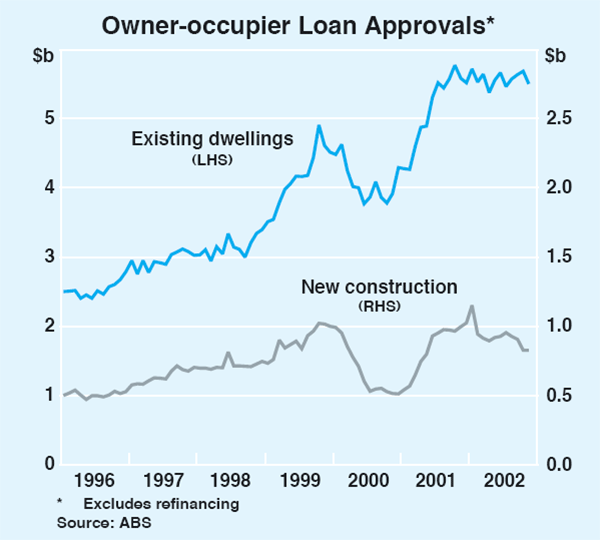
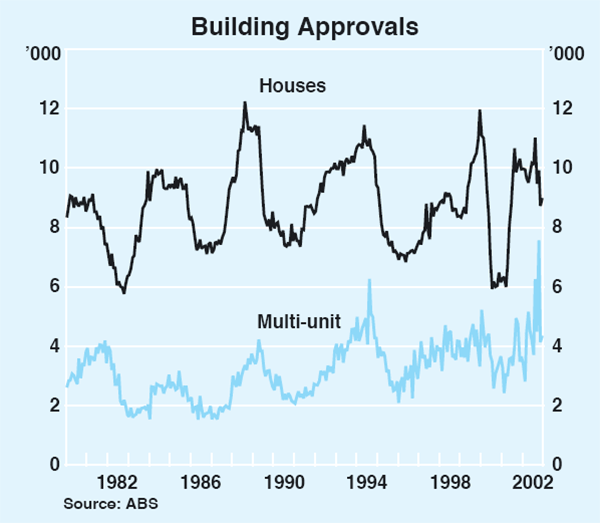
The prospective decline in new housing construction is likely to be partially offset by continued growth in spending on alterations and additions. Loan approvals for alterations and additions have surged in recent months, while the value of building approvals for large alterations and additions is higher over the year. The rise in house prices over recent years has increased the incentive to renovate, and activity in this segment of the market should also be supported over the course of 2003 by an easing in capacity constraints in the building sector.
There are some tentative signs of an easing of price pressures in the housing market, after the strong rises over recent years. The value of monthly loan approvals to owner-occupiers for existing dwellings has remained relatively flat for over a year. Auction clearance rates have fallen in Sydney and Melbourne and there has been a fall in the number of properties being auctioned. Declining clearance rates in the past have tended to be associated with weaker demand and a slowing in dwelling prices.
Much of the pressure in recent years has been associated with demand from investors, but there are also signs of an easing in pressures in the sectors favoured by investors. Loan approvals to investors appear to have levelled out in recent months, after rising rapidly over the preceding two years. Consistent with an increase in the supply of rental properties, the Real Estate Institute of Australia (REIA) reported that median house and multi-unit dwelling rents were flat or declined somewhat in Sydney and Melbourne in recent quarters, while signs of weakening rental markets have emerged in other cities. In addition, rental vacancy rates as measured by REIA are currently at high levels in most capital cities and have generally been on an upward trend over the past three years.
Data available on dwelling prices for the December quarter have been mixed (Table 9). The Residex repeat sales index, which abstracts from compositional changes in the stock of dwellings being sold, suggests that house prices in Sydney rose modestly, while house prices in Melbourne and Brisbane fell. The data also suggest that unit prices rose modestly in the December quarter in Sydney, Melbourne and Brisbane. In contrast, Commonwealth Bank data recorded further strong rises in the December quarter in most cities across Australia, with house prices increasing by 8 per cent and unit prices by 15 per cent in the quarter. However, these data appear to have been affected by the compositional change associated with the declining share of first-time purchasers in the market, who tend to purchase lower-priced properties.
| CBA | Residex | ||||
|---|---|---|---|---|---|
| Houses | Units | Houses | Units | ||
| Sydney | 12.5 | 13.6 | 1.8 | 1.5 | |
| Melbourne | 0.0 | 20.4 | −2.9 | 2.7 | |
| Brisbane | 6.8 | 3.5 | −1.4 | 2.9 | |
| Adelaide | 9.1 | 10.7 | |||
| Perth | 1.3 | 3.3 | |||
| Canberra | 10.7 | ||||
| Hobart | 0.0 | ||||
| Australia | 7.7 | 14.8 | |||
|
Sources: CBA; Residex |
|||||
The business sector
Growth in the goods sector continues to be buoyed by the strength in construction and related manufacturing industries (Graph 30). The high levels of consumption spending and construction activity have also underpinned growth in the wholesale trade and transport and storage industries. In contrast, growth in the service sectors has been more subdued, driven largely by weakness in business services. However, the sharp deceleration of growth in business services, which had been evident for much of the past eighteen months as firms reduced discretionary spending, appears to have been arrested. Both business services and tourism are now showing tentative signs of improved conditions.
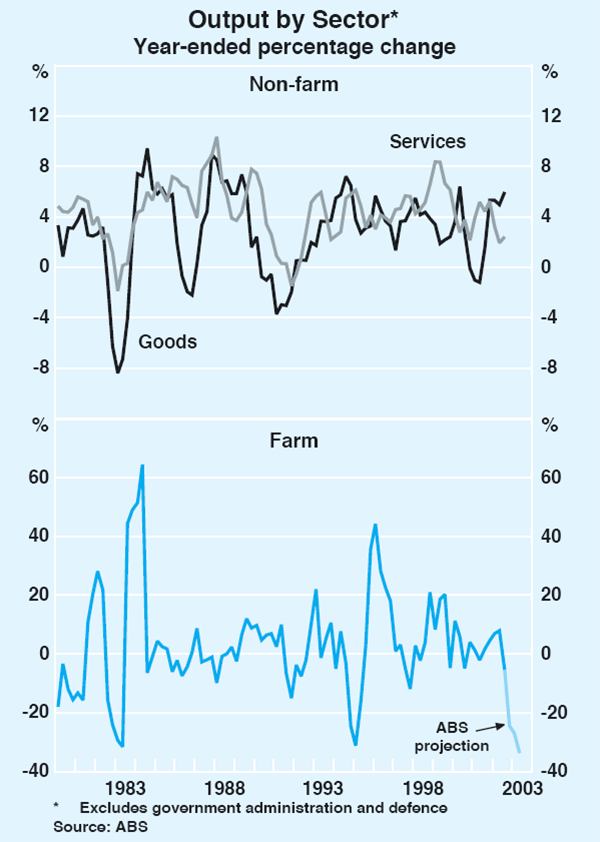
Consistent with this positive tone, business surveys are generally reporting business conditions consistent with strong growth in the non-farm economy (Graph 31). Business conditions, as reported in the broadly based NAB survey, are well above average levels, with firms more exposed to the domestic economy continuing to report the most favourable conditions. The ACCI-Westpac and AIG surveys of the manufacturing sector are also reporting solid business conditions, with indicators of production, employment and new orders around or above their long-run average levels. An exception is the Dun & Bradstreet survey, where respondents continue to be pessimistic about most indicators of actual and expected activity. In all the surveys, businesses are less confident about the future than they are about current conditions, but in most surveys business confidence is around its long-run level.
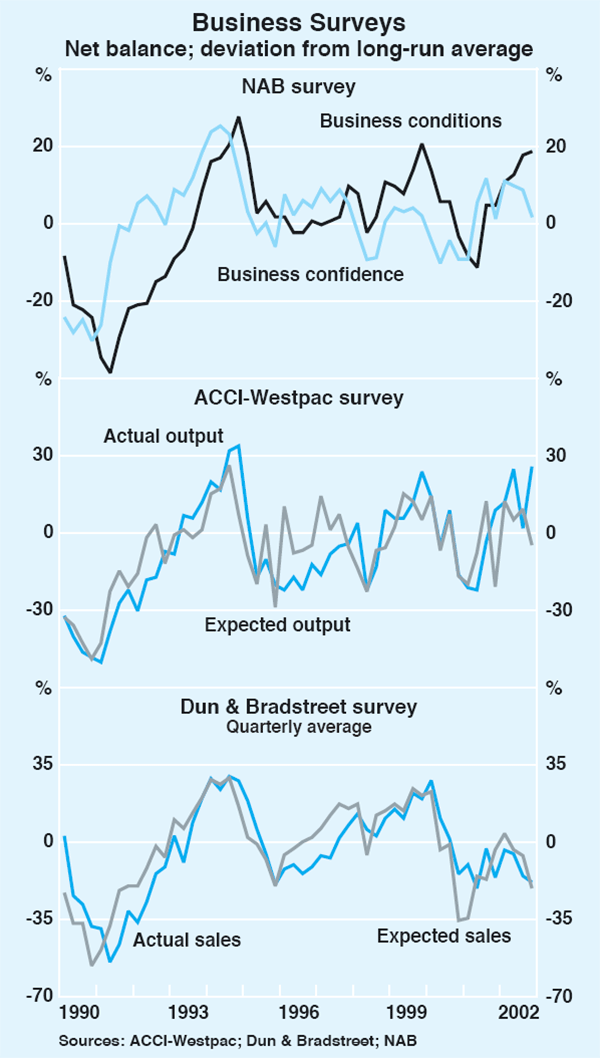
The farm sector continues to be severely affected by the drought. ABS projections, based on the most recent Australian Bureau of Agricultural and Resource Economics (ABARE) forecasts of farm production, imply that real farm output is likely to fall by 34 per cent over the year to the June quarter 2003, a decline similar to that experienced in previous major drought episodes (Graph 30). Farm stocks and stocks held by farm marketing authorities, which were built up sharply owing to the very large 2001/02 wheat crop, are also being unwound as the crop is exported. Expectations for farm income and investment, as measured by the Rabobank rural confidence survey, remain very subdued.
Corporate profits, as measured by gross operating surplus (GOS), rose by 3¼ per cent in the September quarter and as a share of GDP they remained at levels above the average of the past decade (Graph 32). Strong activity in the retail, wholesale and construction industries was reflected in significant rises in profits in those sectors in the quarter, whereas profits declined in these sectors more exposed to the global economy, in particular mining. The profits of small businesses, as measured by the GOS of unincorporated enterprises, have fallen slightly over the past two quarters, mainly reflecting the effect of the drought on the farm sector, with small businesses in the retail and residential construction sectors faring relatively better. Business surveys generally show that firms in the non-farm sector remain upbeat about the outlook for profits.
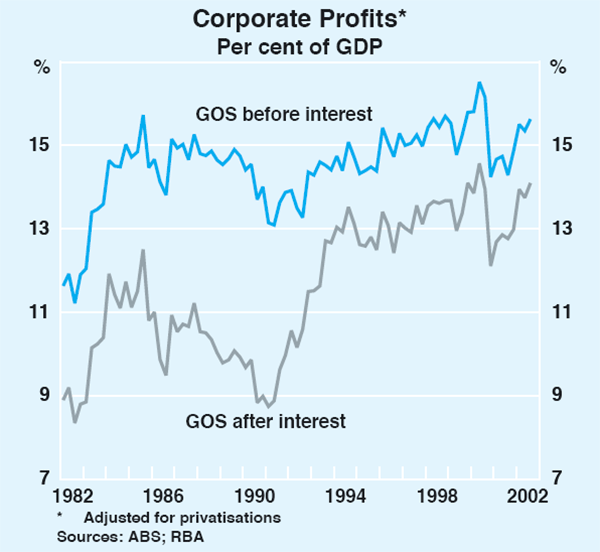
The high level of corporate profits has boosted retained earnings, with business internal funding reaching 7½ per cent of GDP in the three quarters to September (Graph 33). Non-intermediated debt and equity raisings have also remained at a high level, but recourse to intermediated debt has been relatively low. Business credit increased by 3½ per cent over 2002. While the debt-to-equity ratio for the private non-financial corporate sector rose slightly in the September quarter, this measure of gearing still remains considerably below its average level of the past few years. Accordingly, the interest burden of the business sector remains quite low.
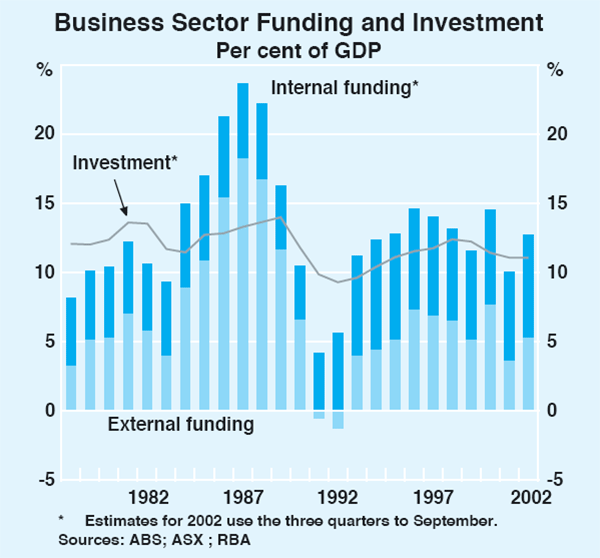
The relatively low level of the capital stock as a percentage of GDP, strong growth in domestic demand and the availability of low-cost funding have supported the year-long recovery in investment spending, with business investment rising by 13 per cent over the year to the September quarter. Spending on both machinery and equipment and buildings and structures has increased strongly, while there are also some signs of a recovery in technology investment, with expenditure on computer software growing by around 9 per cent over the six months to the September quarter.
Further growth in investment spending is likely. While investment as a share of GDP has risen over the past year, it remains well below previous cyclical peaks. Indicators of investment intentions point to a similarly bright outlook. The September quarter ABS capital expenditure (Capex) survey suggests that investment in machinery and equipment is expected to grow by around 11 per cent in nominal terms in the current financial year, assuming a five-year average realisation ratio (Graph 34). The pick-up is expected to be concentrated in the mining, manufacturing and transport and storage sectors, with investment in civil aircraft expected to contribute strongly to overall growth in 2002/03. The drought and associated fall in farm income are likely to induce weaker spending on agricultural equipment, providing a restraining influence on overall investment in machinery and equipment. However, the ability of farmers to smooth their pre-tax income using Farm Management Deposits may result in a less pronounced fall in farm investment than has occurred in previous droughts.

Forward-looking indicators of investment in buildings and structures remain positive, with activity expected to be underpinned by a considerable build-up of work in the early stages of construction. Resource-related commencements rose to a record high in the September quarter, while spending on infrastructure projects should remain buoyant owing to the large number of major projects commissioned by various state governments (with significant private-sector involvement), particularly in the transport and utilities sectors, but also including preparations for the Commonwealth Games. The recent surge in forward indicators for non-residential construction has resulted in a sizeable amount of work in the pipeline in this sector, particularly relating to office construction and the retail sector. The Access Economics Investment Monitor also shows a number of sizeable projects in the early stages of planning (mainly resource-related).
The labour market
The ongoing expansion of economic activity is evident in the labour market, with employment increasing by 0.9 per cent in the December quarter, to be 2.5 per cent higher than a year earlier (Graph 35). In contrast to the previous year, full-time employment made a significant contribution to total employment growth, accounting for about 40 per cent of the jobs created over the year. Part-time employment continues to grow strongly, increasing by 1.9 per cent in the December quarter to be 5.2 per cent higher than a year earlier. The unemployment rate has fallen by 0.7 percentage points from its recent peak in the December quarter 2001 to 6.1 per cent.
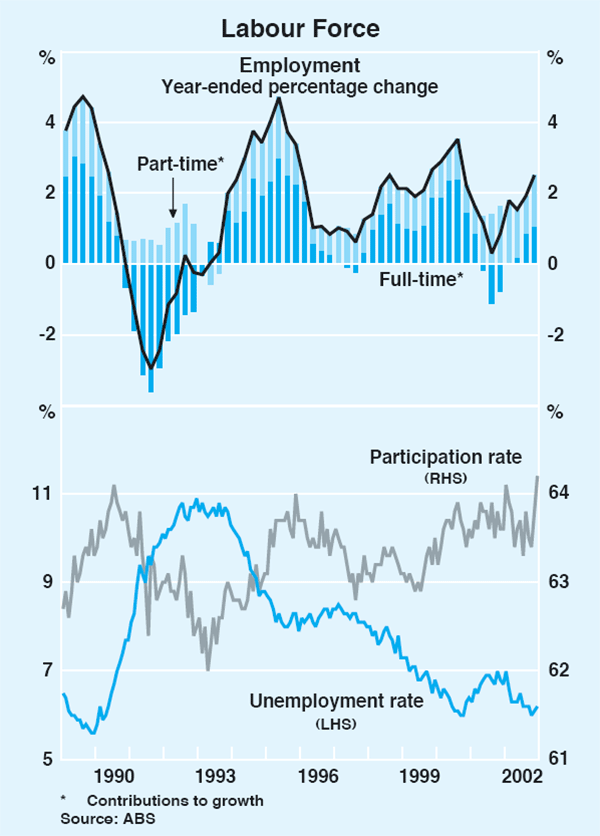
All states experienced positive employment growth and a decline in their unemployment rates over 2002 (Table 10). Employment outcomes have been strongest in Queensland, with employment growing by 3.3 per cent over the year to the December quarter, and the unemployment rate in that state falling by one percentage point. A similar sized fall in unemployment rates was also recorded in Victoria and South Australia. In Tasmania unemployment persists at a significantly higher rate than in the rest of the country.
| Employment growth | Unemployment rate | ||||
|---|---|---|---|---|---|
| December quarter |
Year to December quarter |
December quarter |
Year to December quarter(a) |
||
| NSW | 0.6 | 2.2 | 5.9 | −0.5 | |
| Victoria | 1.0 | 2.5 | 5.8 | −0.9 | |
| Queensland | 0.9 | 3.3 | 7.0 | −1.0 | |
| WA | 0.6 | 2.2 | 6.1 | −0.4 | |
| SA | 0.7 | 2.3 | 6.0 | −1.0 | |
| Tasmania | 0.9 | 0.1 | 8.5 | −0.1 | |
| Australia | 0.9 | 2.5 | 6.1 | −0.7 | |
|
(a) Percentage point change Source: ABS |
|||||
Industry trends in employment have been generally consistent with the pattern of output growth. Employment growth in the goods sector has remained buoyant over the past year, driven largely by increases in employment in the manufacturing, retail trade and construction sectors, though growth in construction employment has decelerated markedly over the past couple of quarters (Table 11). The largest contribution to employment growth over the past year was made by the property and business services sector, following a particularly sharp slowdown over 2001. Employment in industries exposed to tourism, such as transport and storage and accommodation, cafes and restaurants, has been very weak, though it appears to have turned around more recently. Reflecting the effects of the drought, agricultural employment fell by around 18 per cent over the year to the December quarter. Falling farm employment has been evident in most states, but has been most acute in northern and western NSW, where the drought is especially severe.
| Growth | ||
|---|---|---|
| Share of total 2002 |
Year to December quarter 2002 |
|
| Agriculture | 4.3 | −17.6 |
| Goods production | 21.3 | 3.6 |
| Manufacturing | 12.0 | 4.7 |
| Construction | 7.6 | 1.0 |
| Goods distribution | 24.3 | 1.5 |
| Retail and wholesale trade | 19.9 | 2.9 |
| Transport and storage | 4.3 | −4.7 |
| Business services | 17.1 | 4.7 |
| Property and business services | 11.5 | 6.9 |
| Finance and insurance services | 3.7 | −1.0 |
| Communication services | 1.8 | 2.8 |
| Household services | 28.6 | 3.2 |
| Accommodation, cafes and restaurants | 4.9 | 0.6 |
| Education | 7.0 | 2.0 |
| Health and community services | 10.0 | 4.8 |
| Cultural and recreational services | 2.6 | 3.9 |
| Total(a) | 100.0 | 2.5 |
|
(a) Includes public administration and defence, personal and other services, mining and utilities Source: ABS |
||
The pick-up in employment over 2002 has been associated with a slowing in the growth of labour productivity from the rapid pace recorded in 2001, though most measures of productivity remain around the trend growth rates observed over the 1990s. Over the year to the September quarter, output per person employed increased by 1.7 per cent. On an hours-worked basis, labour productivity rose by 2.3 per cent over the year to the September quarter, reflecting the continued decline in average hours (Graph 36).
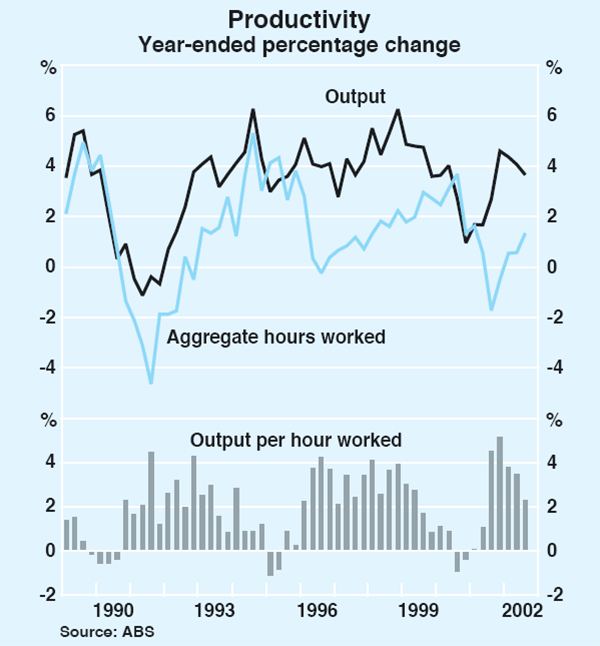
Forward-looking indicators of labour demand have generally eased over the past few months, and suggest that in the near term, employment growth is likely to moderate from its current rapid pace. The ABS employer-based measure of vacancies fell by 3.5 per cent in the December quarter, but remains 10 per cent higher over the year (Graph 37). Measures of print-based vacancies have also slowed in recent months, though they are still above the levels of a year ago. The ANZ Bank series fell in the three months to January, but is 2½ per cent higher than the same time last year. The DEWR measure of skilled vacancies in the three months to January was 5½ per cent higher than in the corresponding period a year ago. With the exception of the Dun & Bradstreet survey, survey-based measures of employment intentions generally remain at levels consistent with above-trend employment growth.
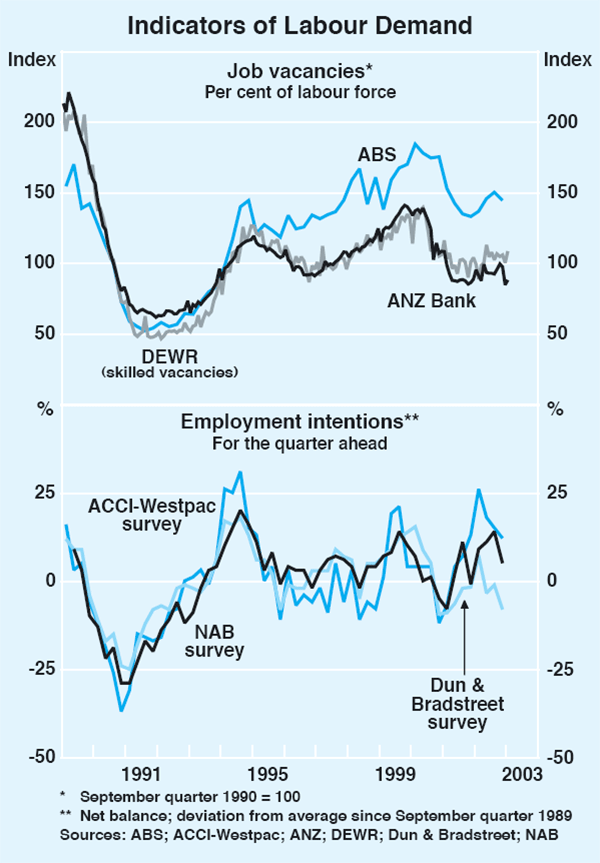
Balance of Payments
The slow growth experienced by Australia's trading partners and the effects of the drought resulted in a much weaker than average export performance over 2002, with export growth close to zero through the year. Over the same period, the strength in domestic demand in the Australian economy was reflected in strong growth in imports. As a result of these developments, the trade deficit widened to around 3 per cent of GDP in the December quarter, compared with a deficit of about ½ per cent of GDP a year earlier. Assuming the net income deficit as a proportion of GDP remained constant in the December quarter, the current account deficit is likely to have reached around 5¾ per cent of GDP (Graph 38).
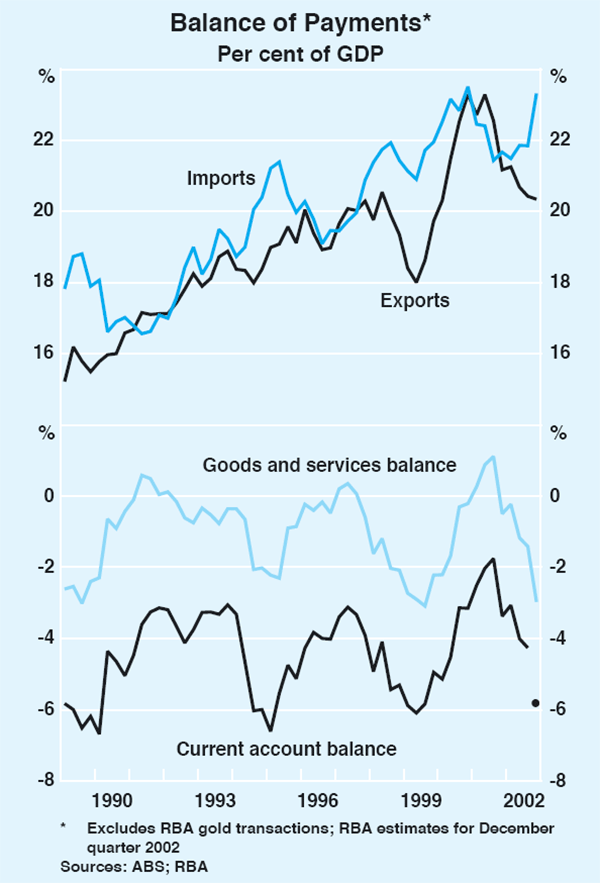
While the value of exports was broadly unchanged over 2002, it was around 6½ per cent lower than the peak in mid 2001 (Table 12). The weak global economy has contributed to falls in the prices of resource exports, and has also resulted in growth in the volume of manufactured exports being substantially lower than the average over the 1990s. The notable exception is exports of transport equipment, which rose by around 34 per cent over 2002. Service exports have also been adversely affected by the global economy, as well as by the negative impact on international tourism arising from heightened concerns about safety.
| Values | Volumes | ||||
|---|---|---|---|---|---|
| June quarter 2001 to December quarter 2002 | Average annual growth over 1990s | June quarter 2001 to December quarter 2002 | Average annual growth over 1990s | ||
| Rural | −13.4 | 5.1 | −11.0 | 7.2 | |
| Resources | −9.0 | 5.4 | −1.1 | 7.9 | |
| Manufactures | 0.0 | 11.9 | 6.1 | 12.8 | |
| Services | −1.6 | 9.2 | −6.1 | 7.5 | |
| Total | −6.6 | 7.2 | −2.7 | 7.7 | |
|
(a) Excludes RBA gold transactions and re-exported gold; December quarter 2002 is an estimate Sources: ABS, RBA |
|||||
More recently, there was a large drop in the value of resource exports in the December quarter, which primarily reflected lower volumes, particularly of crude oil and LNG, after some growth in the middle of 2002 from the oilfield development in the Timor Sea. However, the medium-term prospects for growth in natural gas exports are favourable. A major contract to supply LNG to China was awarded last August, in January another long-term contract was secured to supply LNG to Japan, and a preliminary agreement was reached to supply over 1 million tonnes of LNG annually to Korea over seven years.
The drought continues to have a significant adverse impact on the economy in general (see ‘Box A: Economic Effects of the Drought’ in the November 2002 Statement on Monetary Policy) and on rural exports in particular, although a draw-down of stocks has helped to limit the scale of the fall in the value of rural exports to date. Over the year to the December quarter, the value of rural exports fell by 8 per cent, while the volume is estimated to have dropped by about 4 per cent. The falls were especially large for cereals, where the value exported declined by around 21½ per cent in the December quarter, to be about 34 per cent lower over the year. The Australian Bureau of Agricultural and Resource Economics (ABARE) is forecasting a wheat crop in 2002/03 of just under 10 million tonnes, a drop of almost 60 per cent from the previous year's crop. The sustained dry conditions have also limited water supplies available for irrigated crops, such as cotton and rice, and have resulted in smaller areas planted and lower yields on other winter and summer crops. ABARE's latest forecast implies a fall of 36 per cent in aggregate crop production in 2002/03. A number of agencies have indicated that current weather patterns are typical of an El Niño that breaks down in autumn, though weather patterns through February will be an important guide to the probability of that occurring.
Whereas the drought conditions have resulted in an immediate decline in crop production, meat production in the short run has been boosted, as farmers raised slaughter rates in response to the rising cost of feed. Consequently, the value of meat exports rose by around 8 per cent in the December quarter. Conversely though, once the drought breaks, crop production is expected to recover faster than meat output, owing to the need to rebuild stock numbers. Wool exports have also been affected by the drought, with export volumes around 3¼ per cent lower in the December quarter, as flocks continue to shrink. Notwithstanding the fall in volumes, the value of wool exports rose by about 11½ per cent, as the tight supply conditions have led to sharp increases in wool prices (see the following section on commodity prices).
Merchandise exports to many of Australia's markets declined through 2002 (Graph 39). The falls were especially steep in exports to the Middle East, following two years of double-digit growth. Exports to Japan have also been weak, reflecting the state of that economy. In contrast, the value of exports rose to those economies that have recorded stronger growth outcomes, with merchandise exports over 2002 up by more than 20 per cent to China, around 8 per cent to India and about 5¼ per cent to New Zealand. An exception to this general pattern is that exports to the EU rose sharply in the December quarter, to be 15 per cent higher over the year, despite weak domestic demand in the EU.
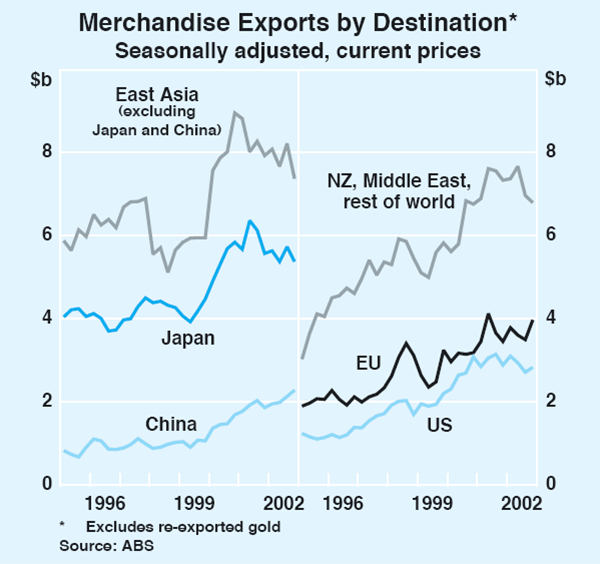
Continued robust growth in domestic final demand has underpinned further solid growth in imports. Over the year to the December quarter 2002, import volumes are estimated to have increased by around 16¼ per cent, with the growth in the value of imports somewhat lower, reflecting the decline in import prices. The strength in imports in 2002 was broadly based, with the increase in capital imports especially strong at 28½ per cent. Imports of civil aircraft have driven the increase in capital imports, with machinery and equipment imports also contributing significantly, reflecting the strong growth in business investment over the year. Over the year to the December quarter, growth in merchandise imports was broadly based, but was particularly strong from China and Hong Kong (Table 13).
| Growth | |||
|---|---|---|---|
| Share of total 2001 | Year to December quarter 2001 | Year to December quarter 2002 | |
| East Asia (excluding Japan, China and Hong Kong) | 21.3 | −1.4 | 15.0 |
| Japan | 13.0 | 2.4 | 4.1 |
| China and Hong Kong | 10.0 | 5.2 | 27.2 |
| EU | 22.5 | 5.8 | 13.6 |
| US | 18.2 | −5.3 | 14.6 |
| Rest of world | 15.0 | −9.5 | 14.1 |
| World | 100.0 | −0.7 | 14.4 |
|
Source: ABS |
|||
The net income deficit widened slightly in the September quarter, but expressed as a share of GDP remained around the level of recent years at 2.8 per cent. In the September quarter, the level of Australia's net foreign liabilities rose by 4.8 per cent, to be around 56 per cent of GDP, but remains close to its average over recent years (Graph 40). The increase primarily reflected the continuation of the recent trend of strong net debt inflows, raising net foreign debt to around 48 per cent of GDP. Net foreign equity liabilities also rose slightly, mainly as a result of valuation effects associated with the Australian share market outperforming equity markets abroad in local currency terms. The ratio of net income payments to exports, a measure of Australia's ability to service its liabilities, at 14 per cent, remains close to the lowest level of the past two decades.
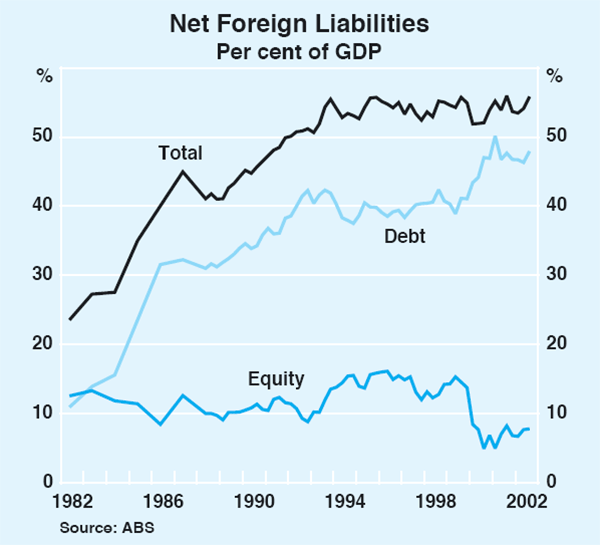
Commodity prices
In aggregate, commodity prices have risen modestly in recent months, with the RBA Commodity Price Index up by around 1 per cent in SDR terms in the three months to January, to be 1¼ per cent higher than a year ago (Graph 41). The recent increase was largely driven by higher base metals prices, with the largest price increases being for nickel, as stainless-steel production surged, and copper, in response to production cuts and strong demand from China. The differential between thermal and coking coal prices widened, as coking coal prices rose by 1¼ per cent in the three months to January, to be 2½ per cent lower than a year ago, while thermal coal prices fell by 5 per cent in the same period, to be almost 20 per cent lower over the year. Reflecting the escalating tensions in the Middle East and on the Korean peninsula, gold prices have risen by around 11 per cent in SDR terms since the beginning of November. As discussed in detail in the chapter on ‘International Economic Developments’, oil prices have also risen rapidly in recent months.
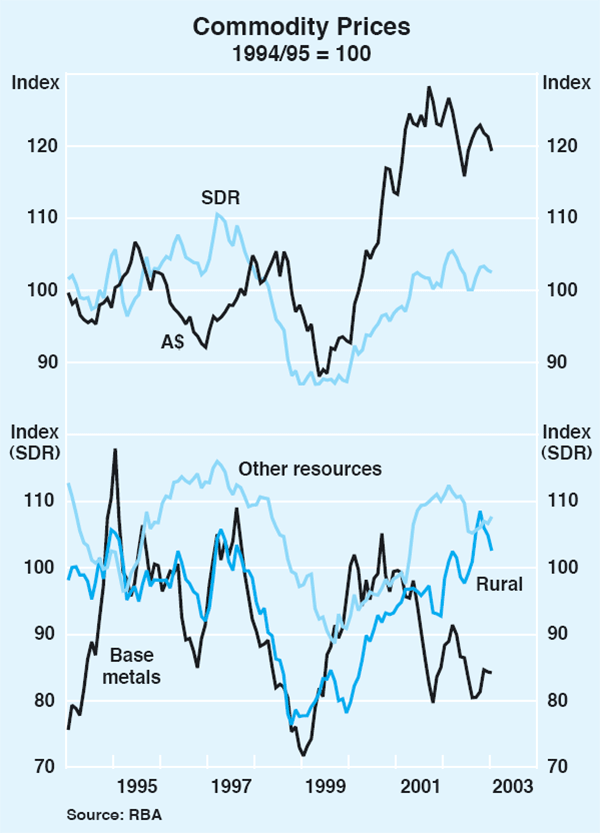
Rural prices in aggregate rose sharply in the second half of 2002, though this masks divergent trends in specific commodities (Graph 42). Wool prices have continued to rise strongly in recent months, to be 57 per cent higher than a year ago – their highest level since June 1990. In contrast, and after rising significantly over the preceding five months, wheat prices have fallen by more than 20 per cent since October, partly in response to increased global supplies and reports of a favourable US wheat crop for the next harvest. Beef prices have continued to fall, as drought-induced slaughtering adds to supply and export demand remains relatively weak.
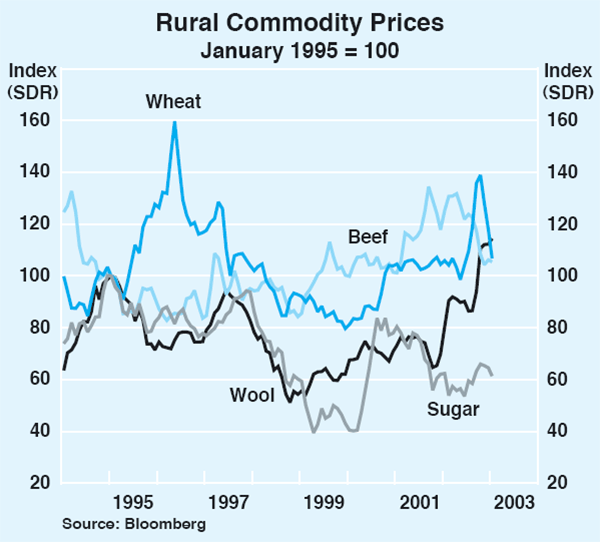
Domestic Financial Markets
Interest rates and equity prices
Money and bond market interest rates
Official interest rates in Australia have remained unchanged since the last Statement, at 4.75 per cent. The last time rates were changed was in June, when they were raised by 25 basis points. Market yields on short-term securities have, however, generally drifted down over recent months (Graph 43). To a large extent, this seems to have reflected developments in US markets rather than domestic developments. Yields on 90-day bank bills have fallen from around 4.85 per cent in early November to around 4.80 per cent now. Yields on longer-term money market securities have fallen by more than those on shorter terms; for example, yields on 180-day bills fell from around 4.85 per cent to 4.70 per cent over the same period. The current structure of short-term rates in Australia suggests that markets are pricing in some probability of a cut in official interest rates over the next six months (Graph 44), though these expectations have fluctuated considerably, especially, as noted, in response to US news.
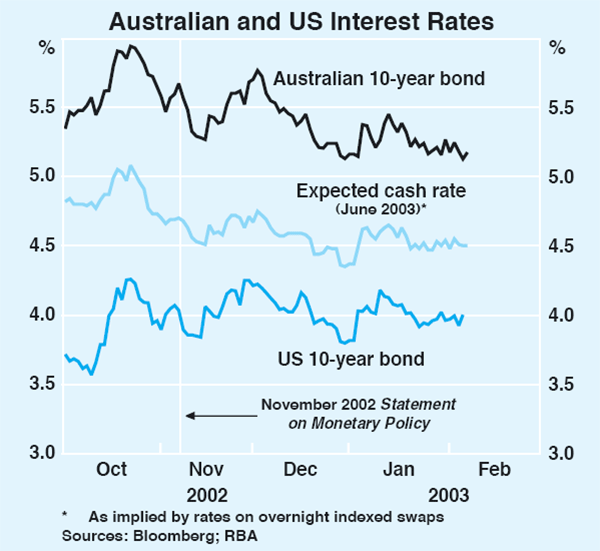
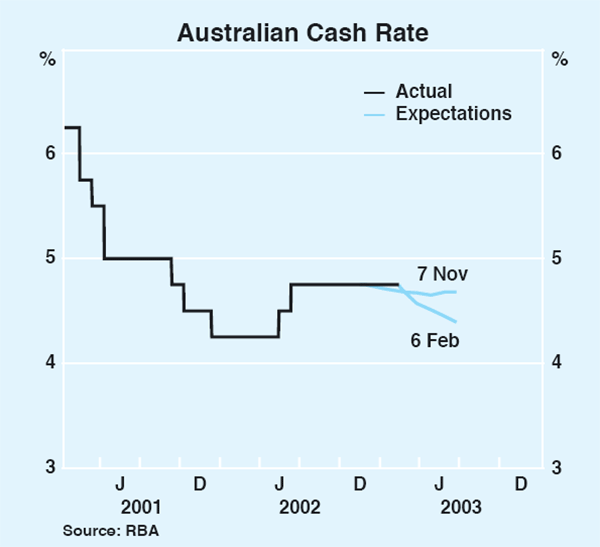
Yields on long-term bonds have shown a similar pattern to short-term rates. The yield on 10-year government bonds fell to the year's low of 5.15 per cent in late December before rising to around 5.45 per cent in mid January and then falling back to around 5.15 per cent. At this level, bond yields are around 45 basis points lower than their level of three months ago and 135 basis points below their peak level in 2002 (Graph 45).
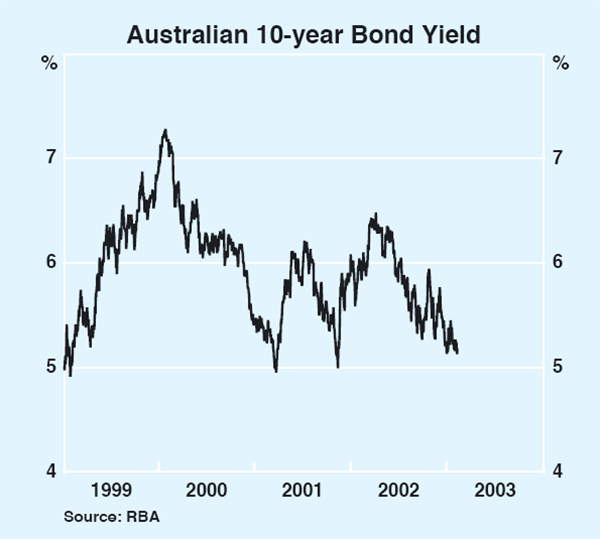
While the run of domestic news, particularly the strong domestic employment outcomes for November and December, has tended to put upward pressure on bond yields, the flow of news from abroad has worked in the other direction. Another factor contributing to the rally in bond yields has been the high level of Australian dollar debt securities issued offshore, particularly in Japan. While the main impact of this issuance has been to reduce swap rates (since issuers use the swap market to hedge their Australian dollar interest obligations), downward pressure has also flowed through to government bond yields as market-makers in the swap market have in turn hedged some of their interest rate risk by buying government bonds.
The slope of the yield curve has flattened considerably since the beginning of 2002, with the cash rate being increased twice in the first half of the year and bond yields falling significantly over the period as a whole (Graph 46). While the spread between 10-year bond yields and the cash rate remains positive at around 40 basis points, it is currently lower than its average over the past decade. Moreover, yields out to four years are at levels below the cash rate. The implications of these developments are discussed in the chapter ‘Assessment of Financial Conditions’.
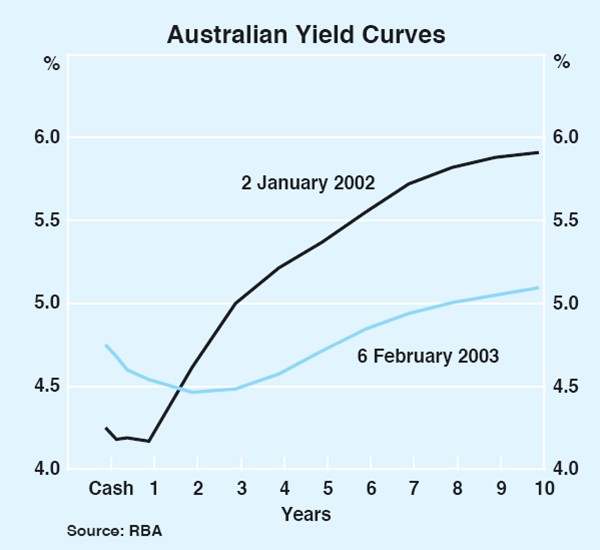
The spread between 10-year bonds in Australia and the US has moved down noticeably from its peak of nearly 200 basis points in mid October (Graph 47) but remains considerably above its average over recent years. In part, the recent narrowing reflects a lessening of the high level of risk aversion which appeared to characterise the US bond market in mid October when 10-year yields in that country fell to four decade lows. The downward pressure on Australian yields arising from offshore bond issues has also played a role.
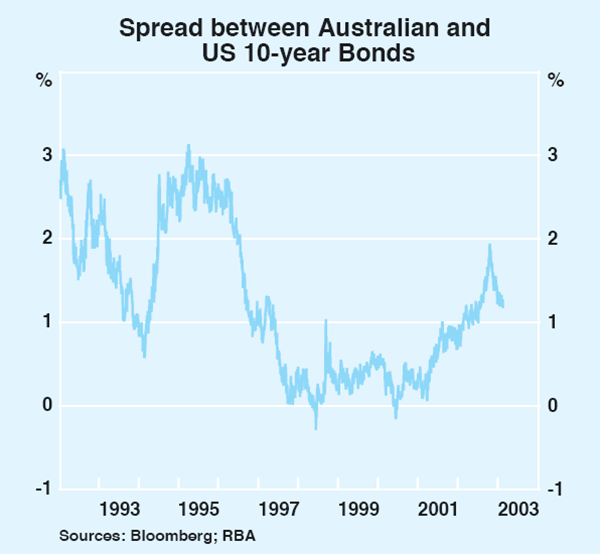
In contrast to the nominal yield spread, the spread between inflation-indexed bonds in Australia and the United States has widened since the previous Statement, reflecting the continuing run of good economic news in Australia and weak news in the US. Real long-term yields in the US are currently less than 2 per cent, which is more than 1½ percentage points below the level at the start of 2002. In contrast, real bond yields in Australia currently stand at around 3¼ per cent, down only slightly on levels a year ago.
Credit spreads
Credit spreads on Australian corporate bonds have narrowed over recent months, reflecting the continuing solid performance of the Australian economy and a decline in spreads abroad (Graph 48). At current levels most spreads are slightly above levels at the beginning of 2002 but around their historical averages. The exception is for BBB-rated bonds for which spreads are lower than they were a year ago. Credit spreads in Australia for a given credit rating remain well below spreads in the US, although the differential has narrowed recently (Graph 49).
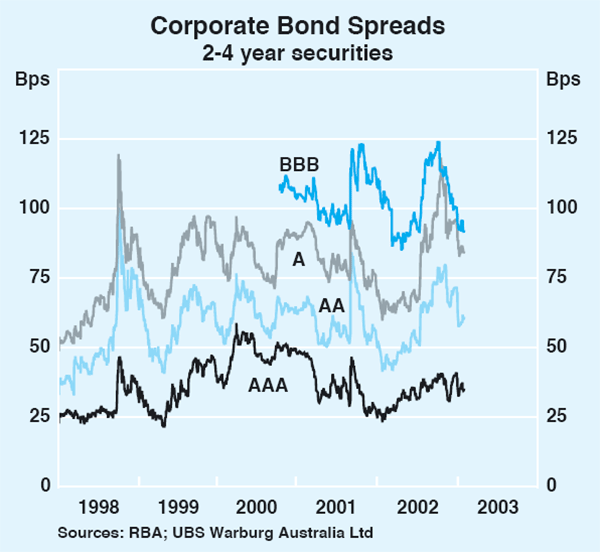
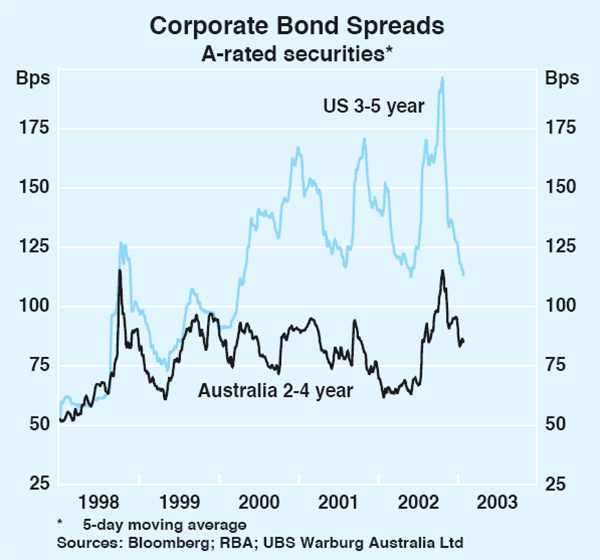
Equity prices
Australian equity prices have declined over recent months but have shown a smaller net fall than have US equity prices since the previous Statement. Over a longer period the Australian market has considerably outperformed its US counterpart, with the ASX 200 falling by 6 per cent over the past three years compared to a fall of 43 per cent in the S&P 500 (Graph 50).
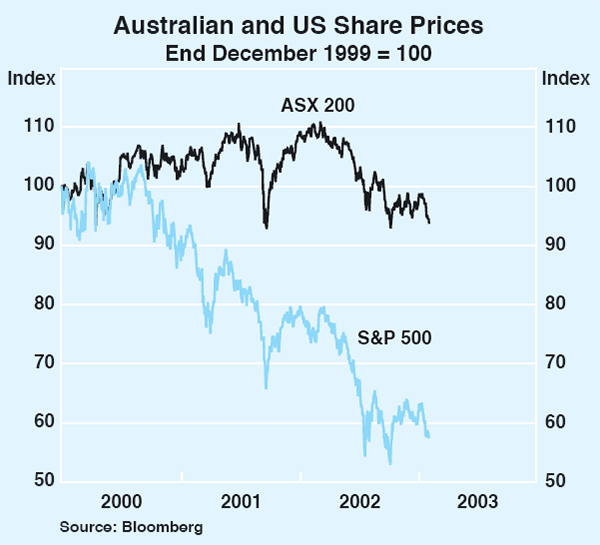
The Australian equity market has been much less volatile than the US market. Over the past three months, the daily change in Australian equity prices has exceeded 1 per cent on 11 occasions, compared to 32 occasions in the US. The recent stability of the Australian market has led to expectations of low levels of volatility going forward. In particular, options prices suggest that the market sees a lower probability of a large decline in the ASX 200 than was the case in late October (Graph 51). At that time the market thought there was a 21 per cent chance of share prices falling by more than 10 per cent. The probability of such a fall is now put at 15 per cent. Options prices also suggest that the Australian market is expected to remain considerably less volatile than the US market over coming months.
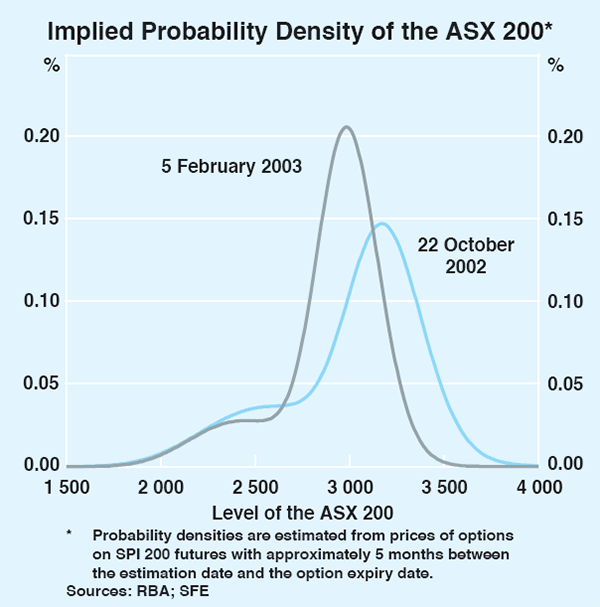
The Australian price/earnings (P/E) ratio has declined over recent months due to both a decline in prices and an increase in reported earnings. At its current level of 23, the P/E ratio is around the average level since 1994 and below the US ratio, which has remained around 28 (Graph 52). Moreover, the Australian ratio is being held up by the large write-offs undertaken by News Corporation last year mainly as a result of its foreign operations; excluding News Corporation, the Australian P/E ratio is only 14, which is broadly in line with its long-run average. The relative levels of P/E ratios in Australia and the US suggest that domestic share valuations are more soundly based than those in the US.
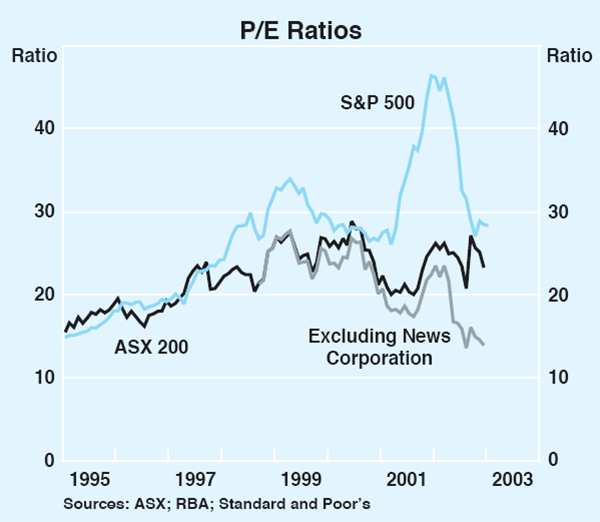
Analysts expect earnings per share for ASX 200 companies to grow by around 10 per cent over 2002/03. This compares with an actual rise of 13 per cent over the last fiscal year and seems more achievable than the recent forecasts for US profits growth over the same period.
The performance of the various industry sectors since the last Statement has been mixed, though the majority of the sectors have recorded price falls since end October (Table 14). The materials and utilities sectors have been the strongest performers. Metals and mining companies in particular performed well, reflecting rises in commodity prices prompted in part by political tensions in the Middle East. There was no net change in the consumer discretionary sector index with a rise in News Corporation's share price (in response to a pick-up in US advertising) offsetting falls in the value of hotel, leisure and retailing companies. In contrast, the financial sector index was down 7 per cent, with banks down 9 per cent, largely reflecting the expected slowdown in housing lending and concerns about the profitability of the banks' funds management operations. The insurance (sub) index has also fallen – it is down 18 per cent since the last Statement – on continuing concerns about investment income and losses arising from bushfires.
| Sector | Change since end October 2002 | Change since end December 2001 |
|---|---|---|
| Energy | −4 | −8 |
| Materials | 2 | −2 |
| Industrials | −4 | −21 |
| Consumer discretionary | 0 | −26 |
| Consumer staples | −2 | −8 |
| Health care | −3 | −47 |
| Financials | −7 | −12 |
| Information technology | −16 | −62 |
| Telecommunication services | −7 | −19 |
| Utilities | 2 | 4 |
| ASX 200 | −4 | −15 |
|
Source: Bloomberg |
||
Intermediaries' interest rates
Intermediaries' indicator variable interest rates have been unchanged for more than six months reflecting the constant target for the cash rate (Table 15). In contrast, banks' fixed rates for small business have fallen by around half a per cent since the previous Statement. This has followed the general decline in long-term market rates during the second half of 2002. Fixed rates on housing loans have declined only marginally since end October, but are about 40 basis points lower than levels six months ago.
| Current level (5 February) |
Change since end October |
|
|---|---|---|
| Variable rates | ||
| Household | ||
| Mortgages: | ||
| – Standard variable | 6.55 | .. |
| – Basic variable | 6.00 | .. |
| – Mortgage managers | 6.35 | .. |
| Personal lending: | ||
| – Residential secured | 6.70 | .. |
| – Credit cards | 16.00 | .. |
| Small business | ||
| Residential secured: | ||
| – Overdraft | 7.30 | .. |
| – Term loan | 6.75 | .. |
| Other security: | ||
| – Overdraft | 8.00 | .. |
| – Term loan | 7.35 | .. |
| Large business | ||
| – Overdraft | 8.35 | .. |
| – Term loan | 8.20 | .. |
| Cash rate | 4.75 | .. |
| Fixed rates (3 years) | ||
| Housing | 6.35 | −0.05 |
| Small business | 6.30 | −0.55 |
| Swap rate | 4.80 | −0.45 |
|
Source: RBA |
||
Financing activity
Debt markets
Gross domestic issuance of non-government bonds remained strong in the December quarter, underpinned by record issuance of asset-backed securities (Graph 53 and Table 16). Issues of bonds by non-financial entities were steady, with a number of infrastructure providers and property trusts tapping the market. The bulk of bonds, however, were issued early in the quarter with the seasonal decline in December significantly more marked than has been the case in previous years. In part, this decline reflects the attractive pricing that a number of issuers have been able to obtain in offshore markets. There have also been signs that domestic investors have had their appetites temporarily sated for some types of bonds, particularly credit-wrapped bonds, with a number of issuers either postponing or reducing the size of their issues. There has been no non-resident issuance into the Australian market since July 2002.
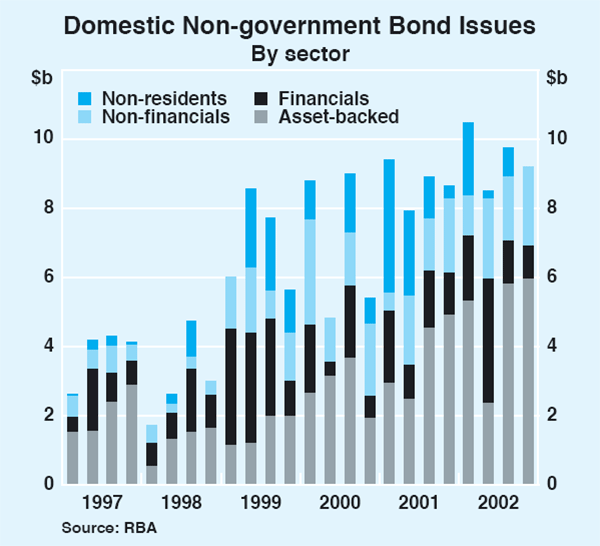
| Sector | 2000 | 2001 | 2002 | 2002 | 2003 | |
|---|---|---|---|---|---|---|
| September quarter |
December quarter |
January | ||||
| Domestic issuance | ||||||
| Domestic corporates | ||||||
| – Financials | 5.1 | 6.0 | 7.7 | 1.2 | 1.0 | 0.0 |
| – Non-financials | 8.6 | 6.1 | 7.6 | 1.9 | 2.2 | 0.1 |
| Non-residents | 3.5 | 7.8 | 3.1 | 0.8 | 0.0 | 0.0 |
| Total non asset-backed | 17.2 | 19.9 | 18.3 | 3.9 | 3.2 | 0.1 |
| of which: | ||||||
| – Credit-wrapped | 3.8 | 2.0 | 3.6 | 0.8 | 1.7 | 0.0 |
| – Floating rate notes | 6.5 | 5.3 | 6.1 | 1.3 | 1.4 | 0.1 |
| Asset-backed | 10.8 | 13.7 | 19.5 | 5.8 | 6.0 | 0.1 |
| Total domestic | 28.0 | 33.6 | 37.9 | 9.7 | 9.2 | 0.2 |
| Offshore issuance | ||||||
| – Financials | 18.1 | 23.7 | 31.8 | 10.0 | 9.5 | 7.2 |
| – Non-financials | 3.7 | 6.3 | 7.1 | 1.2 | 2.3 | 0.3 |
| – Asset-backed | 9.0 | 14.3 | 19.0 | 4.7 | 3.6 | 1.7 |
| Total offshore | 30.8 | 44.3 | 57.9 | 15.9 | 15.4 | 9.2 |
|
Source: RBA |
||||||
Despite the high level of issuance in the quarter as a whole, the volume of non-government bonds outstanding has remained broadly unchanged, reflecting a relatively high level of maturities (Graph 54). Currently, the level of private sector bonds outstanding is $125 billion, which exceeds Commonwealth and state government bonds outstanding by $20 billion.
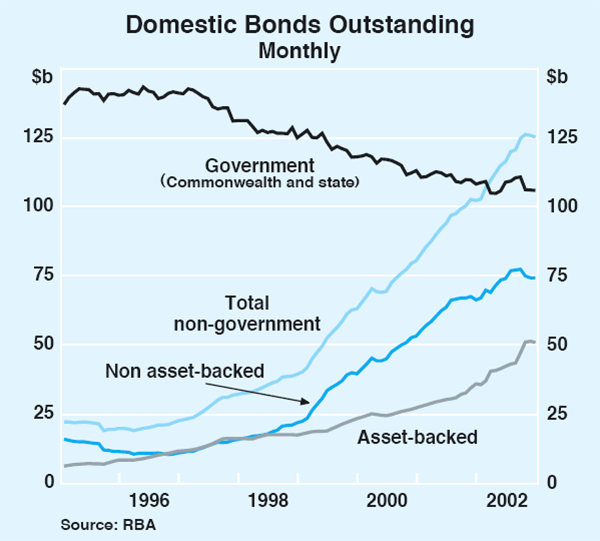
Offshore issuance of bonds by Australian entities was strong through the final quarter of 2002 (Graph 55) and showed no signs of slowing down in December. In total, $15 billion of new bonds were issued in the quarter, bringing the total for the year to $58 billion, up 30 per cent on the total for 2001. Financial institutions remain the largest borrowers, accounting for around 60 per cent of total offshore borrowing over the past few years. Moreover, financial institutions have relied increasingly on offshore markets, with around 90 per cent of all bonds issued by them in the second half of 2002 being issued offshore, compared with an average of 75 per cent since 1997. In part this reflects the ability of financial institutions to react quickly to the favourable offshore funding opportunities that have arisen in recent times. Most offshore raisings are in foreign currency but with foreign exchange risk being offset by swaps back to Australian dollars.
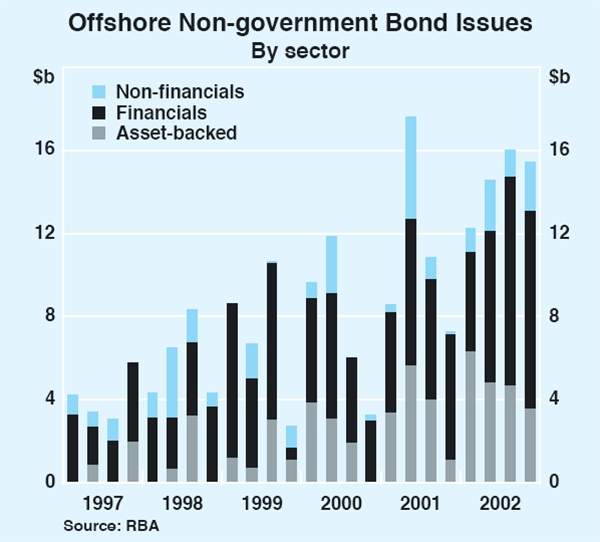
As noted earlier, issuance of Australian dollar debt securities offshore, particularly in Japan, has been very strong. Uridashi issuance amounted to $4.2 billion in the December quarter, and reached a monthly record of $4.3 billion in January.
Hybrid securities
Issuance of hybrid securities (i.e. those that contain both debt and equity elements) has also been quite strong recently (Graph 56). Issuers have found these securities an attractive way of raising capital without diluting earnings per share. The relatively stable capital value and steady income stream offered by these securities has attracted strong investor interest, with recent issues being oversubscribed.
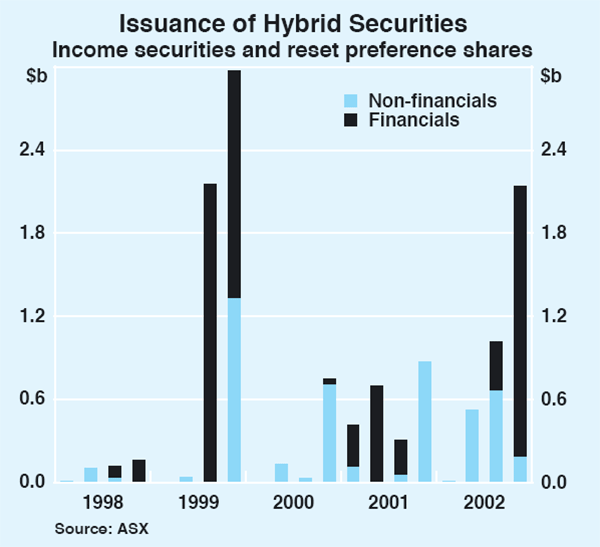
Equity markets
Equity raisings were relatively subdued during the December quarter, with $2.4 billion raised (Graph 57). Most issuance was in the form of placements and dividend reinvestments; initial public offerings totalled just $0.2 billion. Given recent trends in equity prices, investors have shown a preference for established companies rather than companies approaching the market for the first time. A total of $1.9 billion of initial public offerings was made in 2002, constituting only 15 per cent of net equity issuance, compared to an average of over 25 per cent in the 1990s.
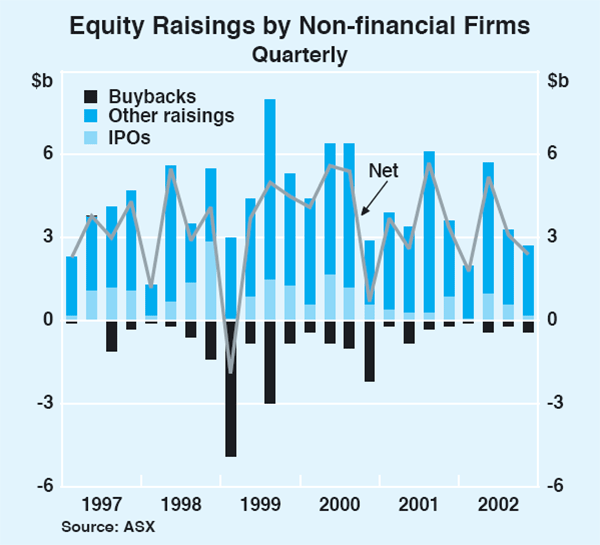
Intermediated borrowing
Reflecting continued low borrowing interest rates, credit growth continues at a strong pace overall, though it has moderated slightly over the past three months (Graph 58). Total credit grew at an annualised rate of 7.9 per cent over the December quarter 2002, down from the 13.4 per cent annualised growth recorded in the previous quarter. A further pick-up in the growth of household borrowing was offset by a slowing in business credit.
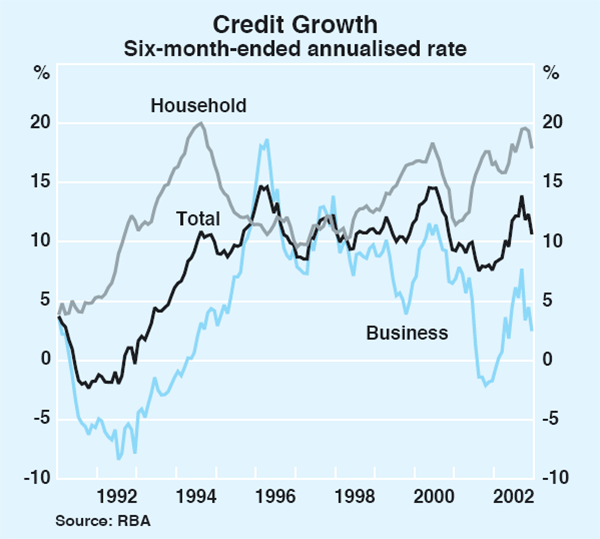
Increased borrowing for housing remains the predominant driver of growth in household credit with borrowing for investment housing being particularly strong. The value of investor housing loan approvals has begun to moderate recently, consistent with other signs of an easing in housing market pressures, which in due course should result in a slowdown in the growth of investor housing credit. Personal credit rose at an annualised rate of 10.2 per cent over the six months to December 2002.
Growth in business credit, which had been increasing for much of 2002, slowed in the December quarter, reflecting reduced demand for credit from businesses in part because of a high level of internal funding resulting from continuing strong profit growth. As such, overall business funding levels remain quite high, suggesting that firms are still well placed to fund future investment.
On the other side of financial institutions' balance sheets, year-ended growth in the broader monetary aggregates has been relatively stable in recent months. Year-ended growth in broad money, at 9 per cent, is below growth in total credit, the difference reflecting the reduced reliance of financial institutions on funding sources that are included in broad money (Graph 59).
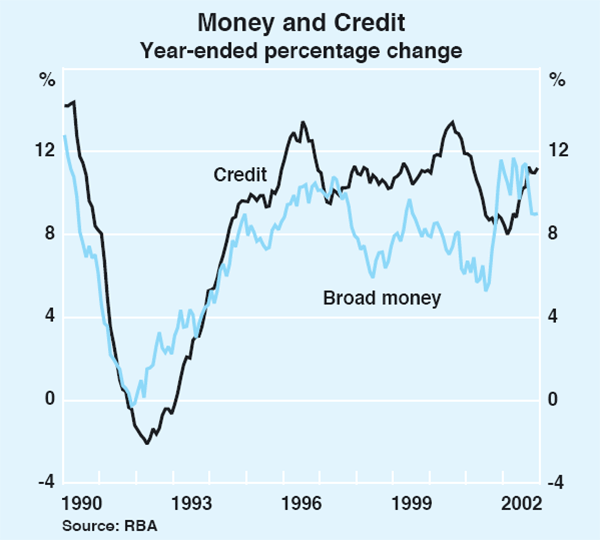
Margin lending
Margin lending for equities and managed funds has been flat for the past three months, in part reflecting the relatively weak performance of the equity market (Table 17). While the number of clients with margin loans increased slightly in the December quarter, this was offset by a small decline in the average loan size. The value of the security underlying margin debt has also changed little, as has the average gearing level. Margin calls were 13 per cent lower in the December quarter than in the previous quarter, reflecting the fall in equity market volatility (Graph 60).
| Level at end | Growth Per cent | ||||
|---|---|---|---|---|---|
| September 2002 | December 2002 | 3 months to December 2002 | 12 months to December 2002 | ||
| Margin debt ($b) | 9.9 | 9.9 | 0.5 | 18.4 | |
| Protected financing ($b) | 0.8 | 0.8 | 0.2 | 73.5 | |
| Total ($b) | 10.7 | 10.8 | 0.5 | 21.4 | |
| Credit limit ($b) | 17.6 | 18.7 | 6.2 | 21.7 | |
| Value of underlying security ($b) | 20.3 | 20.4 | 0.4 | 4.8 | |
| Number of clients | 124,614 | 125,767 | 0.9 | 20.6 | |
| Average number of margin calls per day per 1,000 clients | 4.02 | 3.50 | −12.9 | 66.2 | |
| Average loan size ($) | 86,112 | 85,765 | −0.4 | 0.6 | |
| Credit limit used (per cent) | 61 | 58 | |||
| Leverage (per cent) | 53 | 53 | |||
|
Source: RBA |
|||||
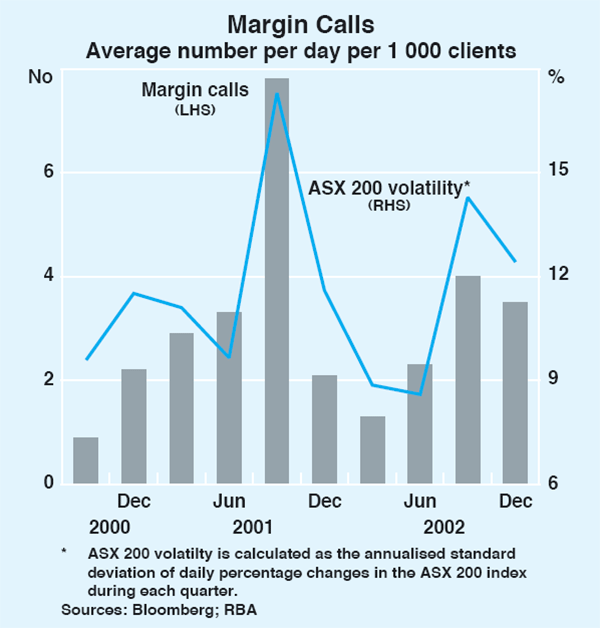
Assessment of Financial Conditions
By most benchmarks, the level of short-term interest rates remains relatively low. The nominal cash rate was increased by a total of 50 basis points in May and June last year, and these increases were also reflected in the main variable borrowing rates of financial intermediaries. These policy adjustments removed some of the monetary stimulus then in place, but the cash rate remains below its recent medium-term averages, both in nominal and real terms, as have the indicator rates of financial intermediaries. At present, on a range of measures, real short-term interest rates are around ¼ to 1 percentage point below their averages over the past five years, and somewhat further below average if a 10-year reference period is used. Conclusions based on these historical benchmarks are necessarily imprecise, since they are partly dependent on the exact reference period chosen and also on the measure of inflation expectations used in the calculation. Nonetheless, it is clear from a range of alternative measures and time periods that short-term rates are moderately below the averages prevailing over the historically relevant recent period.
An alternative benchmark for assessing the policy stance is the slope of the yield curve, which can be broadly summarised by the difference between the cash rate and the yield on 10-year bonds. A strongly upward sloping yield curve would normally be considered to be characteristic of an expansionary policy setting, since it indicates that the cash rate is currently low relative to its expected level in the medium-term future. Conversely, a downward-sloping yield curve is indicative of contractionary monetary policy. As set out in the previous chapter, the slope of the Australian yield curve remains positive at present, but it has flattened considerably since the beginning of 2002. This has been partly a result of the increase in cash rates, but the yield curve has continued to flatten in the period when cash rates have been stable, as long-term bond yields declined.
The decline in bond yields has a number of implications for the assessment of the policy stance. Lower bond yields do impart some stimulus to the economy to the extent that they flow on to the interest rates paid by fixed-rate borrowers – for example fixed-rate mortgage borrowers or corporate bond issuers. But because bond yields embody expectations of future short-term rates, they also convey information about the market's assessment of where the cash rate will be in the future, which in turn will depend on expected economic performance. As noted in the chapter on ‘International Financial Markets’, the recent decline in bond yields has been a global phenomenon, and has reflected generally more pessimistic assessments about prospects for the major economies, with associated downward revisions to the expected path of policy interest rates. Australian bond yields have in fact declined by less than those in the major economies, but have not been immune from the general reassessment of prospects. The flatter yield curve now prevailing suggests that as a result, the market's assessment is that the cash rate is not as far below its expected medium-term path as had previously been the case.
In summary, then, the current level of interest rates is still relatively low when measured against recent historical benchmarks but, based on the movement in the yield curve, could be interpreted as less expansionary than before. The conclusion that financial conditions remain favourable to growth is supported by broader developments in credit markets. The relatively low level of interest rates charged by financial intermediaries has supported a strong pace of expansion of credit to households, particularly in the form of housing-related loans. While borrowing by businesses from intermediaries has been more subdued, there is no sign that business access to external finance is being constrained from the supply side. Aggregate external funding of businesses has remained at quite a good level throughout 2002, notwithstanding some easing of non-intermediated debt and equity raisings towards the end of the year. Narrowing credit spreads in recent months suggest that the availability of funding to businesses is not being hampered by concerns about credit quality.
In addition to these developments, movements in the exchange rate over recent months signal some reduction in the stimulus provided to the traded sector of the economy, though the level of the exchange rate remains on the low side of historical averages. The exchange rate appreciated during much of the second half of last year and rose further in January, both in trade-weighted terms and against the US dollar. In trade-weighted terms, which is the more relevant measure for assessing the impact on the traded sector, the recent movements in the exchange rate have, however, been relatively small. At present the TWI is around 3 per cent above its average level in 2002, but it remains below longer-run benchmarks such as its average over the past decade.
Inflation Trends and Prospects
Recent developments in inflation
Consumer prices
The Consumer Price Index (CPI) increased by 0.7 per cent for the third consecutive quarter in December to be 3.0 per cent higher over the year (Table 18, Graph 61). The various measures of underlying inflation increased by between ½ and ¾ per cent in the quarter, and most measures suggest that underlying inflation is around 2½ per cent in year-ended terms (Graph 62). The underlying inflation measure based on the CPI excluding volatile items is slightly higher, at 2.9 per cent, but it has eased from over 3½ per cent earlier in the year. The statistical measures of underlying inflation based on the distribution of year-ended rather than quarterly price changes are also slightly higher at around 2¾ per cent. Overall, the Bank's assessment is that underlying inflation is currently around 2½ per cent.
| Quarterly | Year-ended | ||||
|---|---|---|---|---|---|
| September quarter 2002 | December quarter 2002 | September quarter 2002 | December quarter 2002 | ||
| CPI | 0.7 | 0.7 | 3.2 | 3.0 | |
| –Tradables | 0.0 | 0.7 | 2.3 | 2.2 | |
| – Non-tradables | 1.3 | 0.7 | 4.0 | 3.7 | |
| Underlying inflation | |||||
| Weighted median(a) | 0.8 | 0.6 | 2.7 | 2.6 | |
| Trimmed mean(a) | 0.6 | 0.7 | 2.5 | 2.4 | |
| CPI excluding volatile items | 0.7 | 0.5 | 3.3 | 2.9 | |
| Market goods and services excluding volatile items | 0.5 | 0.6 | 3.0 | 2.4 | |
|
(a) For more information on these measures see ‘Box D: Underlying Inflation’ in the May 2002 Statement on Monetary Policy. Sources: ABS; RBA |
|||||
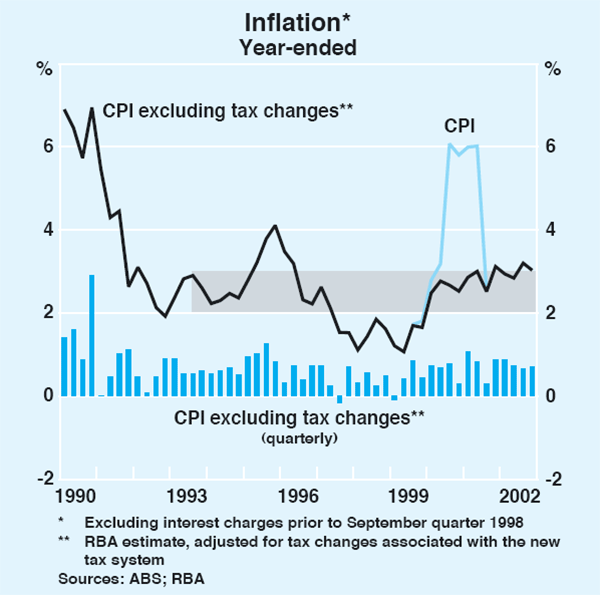
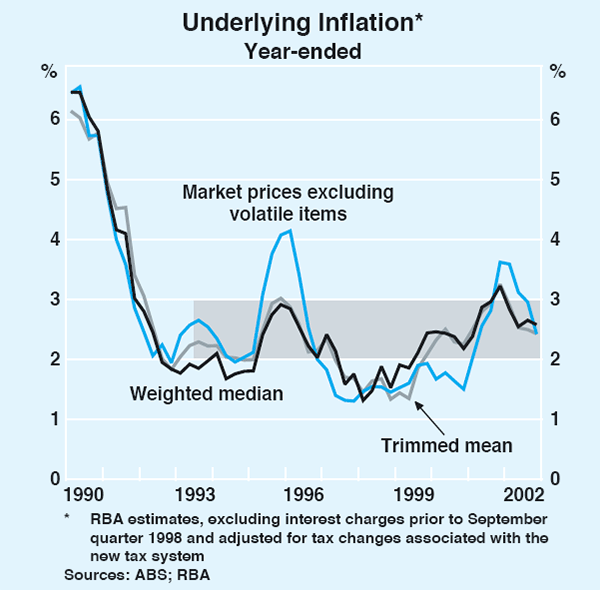
The largest contributors to the increase in the CPI in the December quarter were a 2 per cent increase in fuel prices, which were around 8 per cent higher over the year, and a further large increase in vegetable prices, in part related to the effects of the drought. The drought also contributed to price rises for a number of other food items, including bread and cereal products, fruit and spreads. In year-ended terms, the most significant contributions to CPI inflation were made by petrol prices, the cost of overseas travel and accommodation (primarily reflecting a large increase earlier in the year) and house purchase costs, reflecting the high level of activity in that sector. Ongoing increases in the cost of insurance have also contributed to price rises in a number of items in the CPI. There were a few notable price falls. In particular, audio, visual & computing equipment prices fell by 5 per cent in the quarter and by more than 10 per cent over the year.
The price increases in the quarter came from both external and domestic sources with tradable and non-tradable prices both increasing by 0.7 per cent in the quarter. However, over the past year, the rise in tradable prices has been lower than that of non-tradable prices, reflecting subdued world price pressures and relatively strong domestic conditions. There has also been a continued divergence in the rate of increase of goods prices, which increased by 1½ per cent over the year (excluding volatile items), compared with service prices which rose by 4 per cent.
Producer prices
Upstream inflationary pressures remained moderate in the December quarter, with the exception of higher oil prices, although the declines evident earlier in 2002 appear to have been reversed. Final-stage producer prices increased by 0.5 per cent in the quarter, and were 1.4 per cent higher over the year (Table 19, Graph 63). Construction prices continued to make the largest contribution to the rise in final-stage prices and underpinned the 0.9 per cent increase in domestic final-stage prices in the quarter. In contrast, the imported component of the final-stage price index fell by 0.9 per cent, reflecting further falls in the prices of electronic equipment and in part the appreciation of the exchange rate.
| December quarter 2002 |
Year to December quarter 2002 |
|
|---|---|---|
| Preliminary | 1.7 | 1.4 |
| – Domestic | 1.7 | 2.1 |
| – Imported | 1.5 | −2.1 |
| – Excluding oil | 1.3 | 1.6 |
| Intermediate | 1.6 | 1.2 |
| – Domestic | 1.7 | 1.7 |
| – Imported | 0.6 | −3.0 |
| – Excluding oil | 1.3 | 1.4 |
| Final | 0.5 | 1.4 |
| – Domestic | 0.9 | 3.2 |
| – Imported | −0.9 | −6.1 |
| – Excluding oil | 0.5 | 2.3 |
|
Source: ABS |
||
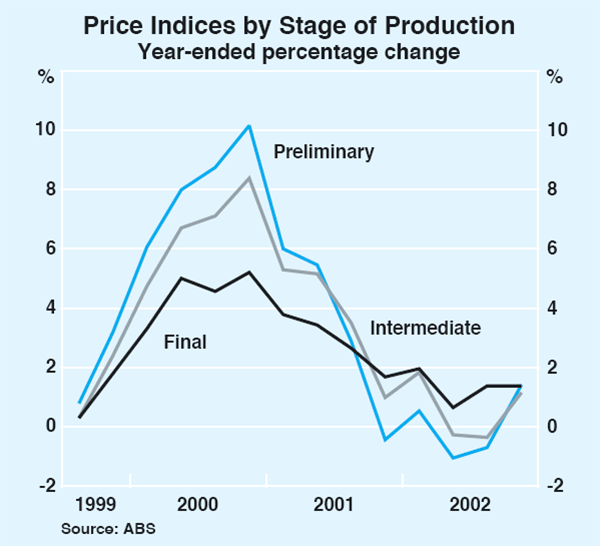
In the December quarter, prices at both the intermediate and preliminary stages of production increased at their fastest pace since June 2001, but remain well below the growth rates recorded at the end of 2000. Large positive contributions were made by price increases for agricultural products such as wheat, reflecting the effects of the drought, and petroleum. Excluding petroleum prices, the imported components of these series continued to fall.
The various business surveys indicate that upstream price pressures also remain moderate at present. The NAB survey reported that growth in purchase costs was unchanged at 0.4 per cent in the December quarter, and businesses expect a similar modest rise in the March quarter. The net balance of firms experiencing cost increases according to the ACCI-Westpac survey of manufacturers has ticked up, having been on a downward trend for the past 18 months or so.
Labour costs
Consistent with the recent tightening in the labour market, signs have emerged that the wage cycle has passed its trough, although most labour cost indicators suggest that wage pressures remain generally moderate. In the September quarter, the wage cost index (WCI) for total pay increased by 0.9 per cent in quarterly seasonally adjusted terms, to be 3.3 per cent higher than a year earlier (Graph 64). At the industry level, the WCI recorded the fastest annual wage growth in mining (4.3 per cent), and the slowest in transport and storage (2.3 per cent) for the third consecutive quarter.
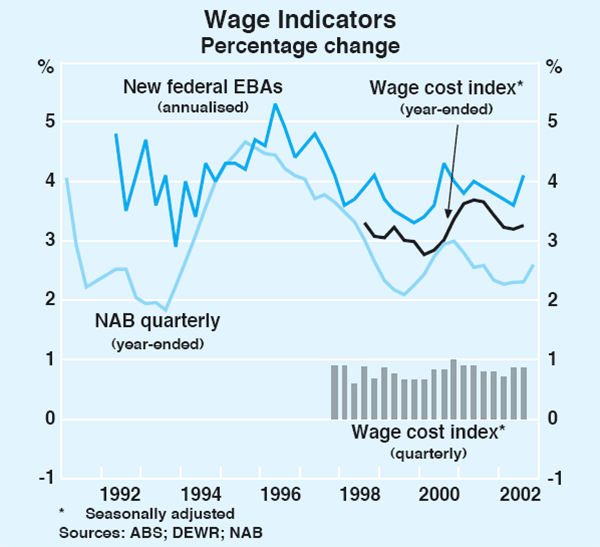
Business surveys also point to some pick-up in the pace of wage growth. Growth in the NAB survey measure of total labour costs picked up slightly over the year to December, and firms are expecting a similar pace in the next quarter. The NAB survey also reports that firms are having some difficulty in attracting suitable labour, although the ACCI-Westpac survey suggests that conditions are somewhat easier in the manufacturing sector.
Similarly, data from the Department of Employment and Workplace Relations indicate that new federal enterprise agreements ratified in the September quarter provided an average annualised wage increase of 4.1 per cent, up from 3.6 per cent in the June quarter, although part of the increase reflects a shift in the industry composition of new agreements from lower-wage sectors to higher-wage sectors (particularly from retail trade to finance). Wage increases for the stock of existing agreements remained at 3.8 per cent in the September quarter. According to the latest Mercer Quarterly Salary Review, executives' base salaries rose by 4 per cent over the year to December, marking a somewhat slower pace than the 4½ to 5 per cent range that has existed over much of the past few years.
The various wage-bill measures continue to give divergent readings. (For a discussion of the interpretation of wage-bill measures, see ‘Box B: Measures of Labour Costs’ in the August 2002 Statement on Monetary Policy.) Average weekly ordinary-time earnings of full-time adults (AWOTE) grew by 1.4 per cent in the September quarter, to be 4.9 per cent higher over the year. The national accounts measure of compensation per employee also grew by 1.4 per cent in the September quarter, but was 3.4 per cent higher over the year. On a per hour basis, compensation grew by 1.8 per cent in the September quarter, to be 4.1 per cent higher over the year, reflecting a decline in average hours worked. Reflecting strong productivity growth, unit labour costs rose by only 0.2 per cent in the September quarter, to be 2 per cent higher over the year.
Inflation expectations
Most measures of inflation expectations remain contained. The latest NAB quarterly survey reported that businesses expect inflation in retail and other final product prices to be 0.4 per cent in the March quarter (Graph 65). Similarly, subdued expectations were reported in the ACCI-Westpac survey of manufacturers. In contrast, consumer inflation expectations, as measured by the Melbourne Institute survey, picked up in the December quarter and remained at the same level in January. While this measure of expectations can be quite volatile, higher outcomes in recent months may reflect expectations of higher petrol prices associated with the risk of war in the Middle East, and higher food prices associated with the drought.
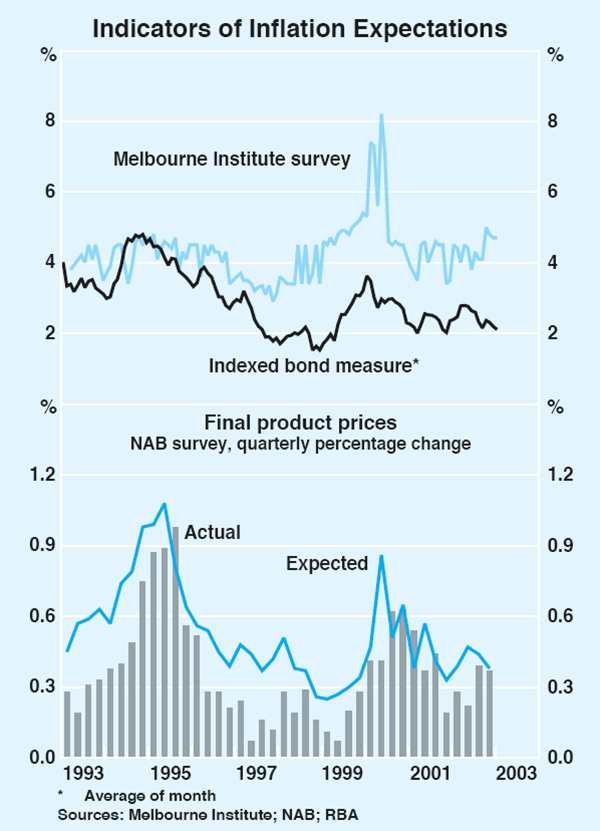
Longer-term inflation expectations of investors, measured by the difference between 10-year bond yields and indexed bonds, declined to around 2¼ per cent over the second half of 2002, and have edged down over the March quarter to date. Financial market economists surveyed by the Bank have revised up their median inflation forecast for the year to June 2003, from 2.6 per cent to 2.8 per cent (Table 20). This partially reflects upward revisions to expected oil prices in the near term. For the year to June 2004, the median forecast fell marginally to 2.4 per cent. The median CPI inflation forecast of trade union officials, as surveyed by the Australian Centre for Industrial Relations Research and Training, has been revised down from 3.5 per cent to 3.3 per cent for the year to June 2003. The median forecast for the year to June 2004 has been revised up by ½ percentage point to 4.0 per cent.
| Year to June 2003 | Year to June 2004 | ||||||
|---|---|---|---|---|---|---|---|
| Aug 2002 | Nov 2002 | Feb 2003 | Aug 2002 | Nov 2002 | Feb 2003 | ||
| Market economists(a) | 2.4 | 2.6 | 2.8 | 2.5 | 2.5 | 2.4 | |
| Union officials(b) | 3.0 | 3.5 | 3.3 | 3.5 | 3.4 | 4.0 | |
| (a) RBA survey (b) ACIRRT survey |
|||||||
Inflation outlook
As discussed in the introduction, inflation in underlying terms has passed the peak reached in 2001 and, in recent quarters, has been close to the middle of the target range. Over the year to the December quarter, underlying inflation was 2½ per cent, and the Bank's assessment is that it is likely to remain around that level during the next 18 months. This represents a slightly lower forecast than was presented in the previous Statement, principally reflecting the appreciation of the trade-weighted exchange rate that has taken place over the past few months. Following our normal practice, the forecasts assume that the exchange rate remains around recent levels, and international oil prices gradually return to the middle of the OPEC target range.
While the Australian economy continues to grow at a good pace, evidence of inflation pressures at present remains quite limited. The pace of upstream price increases eased during most of last year, before strengthening only modestly in the December quarter. Aggregate wage increases picked up slightly in the second half of 2002, but they remain at a pace consistent with the inflation target. While there have been isolated areas where strong demand has generated upward pressure on wages and prices, notably in the housing construction sector, these pressures have not spread across the economy more widely. Prospects at this stage are that inflation will remain contained. Given the weak international environment, the overall pace of growth of the Australian economy appears unlikely to generate significant capacity constraints in the period ahead. With the trade-weighted exchange rate now moderately higher than its average in 2002, and global inflation subdued, there is likely to be little if any inflationary pressure from import prices.
The CPI inflation rate, currently 3 per cent, is likely to remain higher than underlying measures in the short term. The difference between the CPI and underlying measures has reflected a number of sector-specific influences during the past year or so, including the effects of higher oil prices, insurance costs and airfares, as well as the impact of the drought on food prices. Some of these influences are now dissipating but others will continue to affect the CPI inflation rate for a few quarters. The full impact of the drought has not yet flowed through to final food prices; in addition, international oil prices have increased further from their average level in the December quarter, though this effect has been partly dampened by the stronger exchange rate. The impact of food and fuel prices is assumed to fade over the forecast horizon so that CPI inflation returns to around the underlying rate.
One risk to the inflation outlook is that these temporary influences may become incorporated into ongoing inflation expectations, and therefore begin to influence wage and price developments more widely. This risk would be amplified in the event that international oil prices were to rise significantly further. Another source of upside risk to inflation is the growth of domestic demand, which remains strong and could contribute to faster-than-expected growth in the economy overall. The main downside risk to growth and inflation is associated with the international outlook. The global economy is currently experiencing a period of weakness which, at this stage, is expected to be relatively short-lived. However, there is a significant risk that this recent weakening of conditions in the major economies will become more protracted, resulting in a less favourable environment for growth in Australia. In that scenario inflation in Australia would be lower than currently expected. At present these risks to the inflation outlook are judged to be evenly balanced.
Footnote Box: A
The US fiscal year operates October through September. [1]